The galaxy was one of the billions of galaxies that existed in the universe. Composed of some four hundred billion stars in a disk 120,000 light-years in diameter, the galaxy was orbited by seven smaller satellite galaxies, of which five were directly accessible by the time of the Galactic Empire. The galaxy was home to between five and twenty million sentient species, and over one hundred quadrillion sentient beings lived in one billion star systems, interacting with each other through travel, diplomacy, trade, politics, and war. In historical memory, this galaxy had been ruled by the Galactic Republic, the Galactic Empire, the New Republic, and the Galactic Federation of Free Alliances, the Fel Empire, Darth Krayt's Galactic Empire and was home to the Force-using orders of the Jedi and the Sith.
The galaxy was between 100,000 and 120,000 light-years across, or 37,000 parsecs (a parsec is 3.258 light years), and approximately 13 billion years old. The galaxy's luminous disk contained some four hundred billion stars, of which around a quarter had been properly surveyed by the galactic community by the time of the Galactic Empire. The luminous disk revolved around the Galactic Center, a supermassive black hole that massed as much as four million suns. As late as the Declaration of a New Order, only probe droids had ever visited the black hole at Galactic Center. The known galaxy included nearly a billion inhabited star systems, from uncharted smugglers' settlements to planet-spanning ecumenopoleis where scarcely a meter of ground remained untouched. Under the Galactic Empire, nearly seventy million of those system were sufficiently populated to merit some form of representation.
The galaxy bulged around Galactic Center to form a bright sphere known as the Deep Core. This region was around seven thousand light-years across and contained some thirty billion tightly-compacted stars. Towards the center the stars of the Deep Core were only around a hundredth of a light-year apart, and were known to collide and rip out each other's stellar cores. Most of the stars of the luminous galaxy were in a disk of spiral arms rotating around the Deep Core. Galactic civilization named four spiral arms: the Bakchou Arm, the Ettarue Arm, the South Arm, and the Tingel Arm. The brightest supergiant stars were concentrated in the spiral arms, as well as glowing clouds of gas and dust, which contributed to the apparent gaps between the arms even though those areas were full of stars.
Most stars were within a thousand light-years above or below the plane of the luminous disk, forming a two thousand-light-year region known as the "thin disk". For three thousand, five hundred light-years on either side was the "thick disk", which was poorer in stars than the thin disk and even fewer of these had a system of planets.
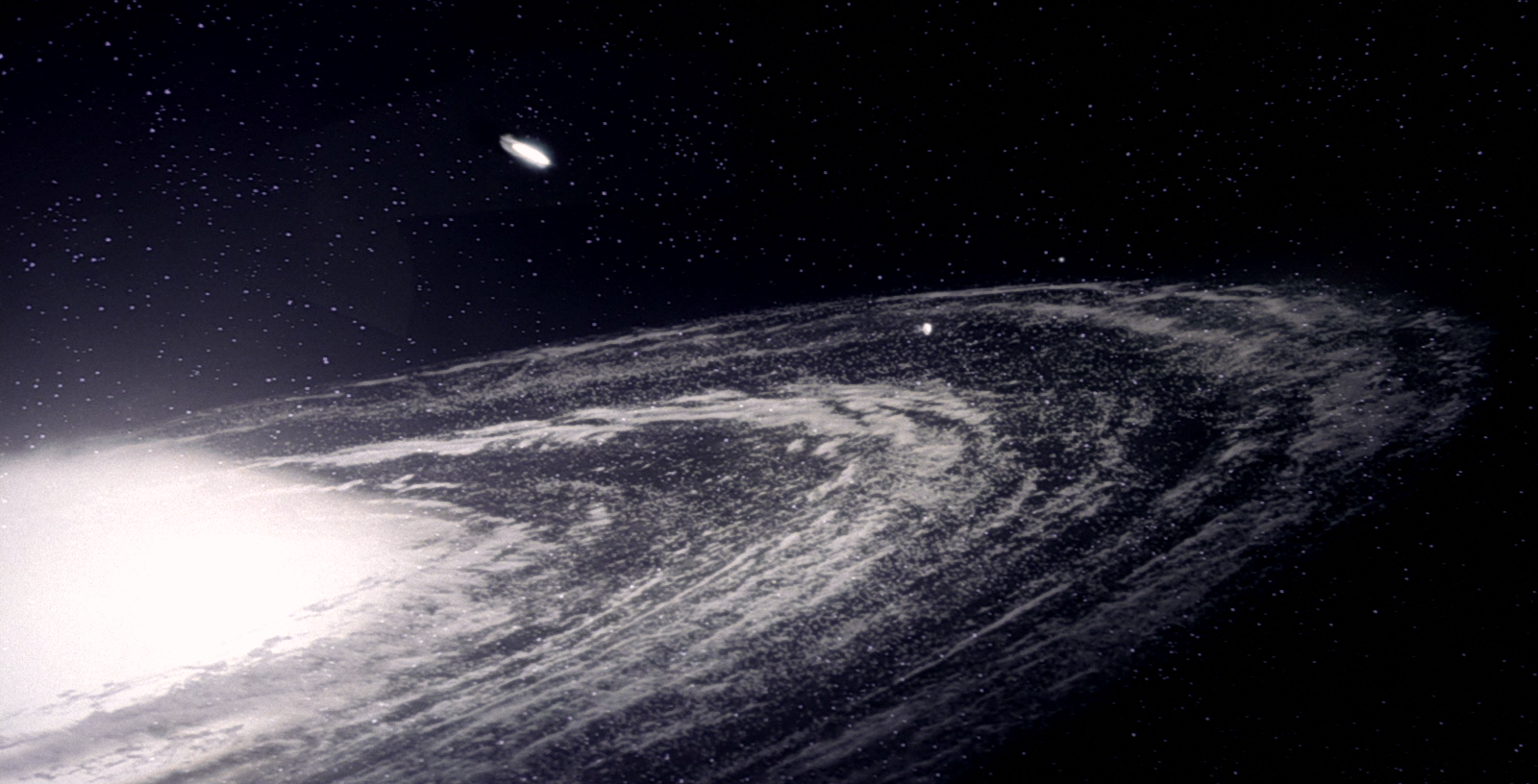
A portion of the galaxy, seen from above the galactic plane, showing the luminous disk, the spiral arms, and the bulge of the Deep Core.
Beyond the thick disk was the stellar halo, a huge sphere surrounding the entire galaxy with a few billion stars in highly elliptical orbits. Nearly two hundred globular clusters orbited in this region. The globular clusters were typically lifeless, packing hundreds of thousands of extremely old, inhospitable stars into only a hundred light-years. Many of the globular clusters, however, were considered extremely beautiful sights, such as Cosm's Well.
The galaxy was orbited by seven dwarf satellite galaxies, some of which contained twenty billion stars. They were ranked in order of distance. The closest was Companion Aurek, also known as the Rishi Maze, a complex tangle of stars high above the galactic plane. Companion Besh, also known as Firefist, was some 150,000 light-years away from the galaxy and had only ever been surveyed by probots. The other satellite galaxies, Companions Cresh through Grek, were much further out. Most of the Companions were described as having ancient, metal-poor remnants of stars and not much life.
A circumferential hyperspace barrier severely complicated hyperspace travel outside the disk and generally discouraged extra-galactic exploration. A band of whorls and eddies that spun around the galaxy too quickly to be traversed at faster-than-light speeds, a number of astrophysicists believed this to be a creation of a mysterious ancient race known as the Celestials. Beyond the galaxy's rim, separating it from other galaxies, was a vast expanse of starless space known as the Intergalactic Void.
While there was a hyperspace disturbance outside of the galaxy, hyperspace made it possible within the galaxy to have an enormous and diverse civilization. Of the galaxy's 400 billion stars, around 180 billion of them were orbited by a system of planets. 90% of the stars of the galaxy fell within the Main Sequence (the other 10% comprised protostars or stellar remnants like white dwarfs, neutron stars and black holes). The larger blue and white stars of the sequence - the O-, B-, and A-type stars - such as Garnib, Kessa and Colu, lived for a few million years and rarely possessed systems that had intelligent life since it had too little time to evolve. The most habitable stars were G- and K-type yellow and orange dwarfs such as Corell and Yavin, which had lifespans of tens of billions of years giving life plenty of time to evolve. G- and K-types between them made up 19% of the galaxy's stars, and 75% of them were habitable. The most common stars in the galaxy, however, were M-type red dwarfs, which comprised 70% of the galaxy's stars, but only 1% of them, such as Barab, were habitable. Very few red dwarfs were settled: most were surveyed by probe droids in the early years of the Galactic Republic and were typically left abandoned unless they possessed mineable resources.
Factoring in the output of heat and light needed for an advanced civilization to form, therefore, there were 7.1 billion truly habitable stars within the galaxy, and about 3.2 billion habitable star systems. It was estimated that about one billion of those systems were actually populated or had been settled by sentient beings.
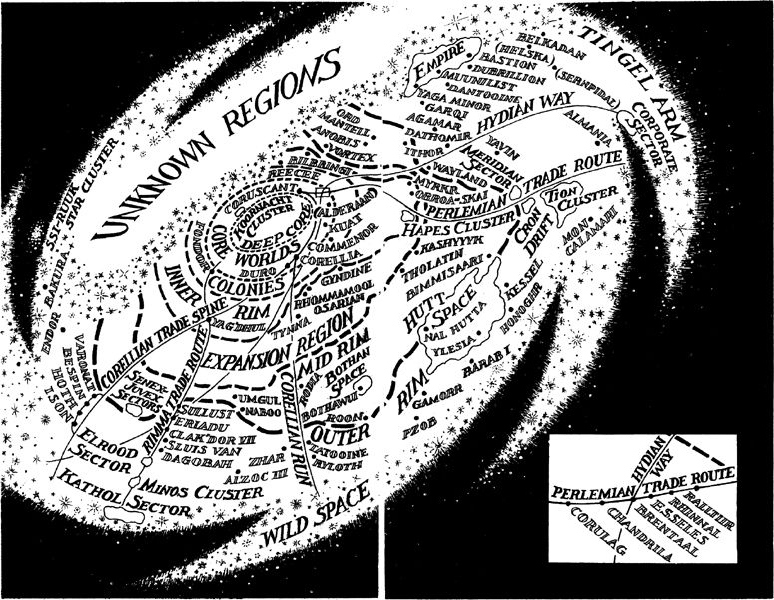
Stylized map of the galaxy, showing the various regions.
The galaxy had many regions, which were largely cultural entities as opposed to political ones, and generally corresponded to stages of galactic exploration and settlement. The nine most famous regions were the Deep Core, the Core Worlds, the Colonies, the Inner Rim, the Expansion Region, the Mid Rim, the Outer Rim Territories, and beyond the galactic frontier, Wild Space, the Unknown Regions and the Galactic Rim. Casual phraseology usually split the galaxy into "the Core" and "the Rim", with the latter consisting of the Expansion Region and parts beyond.
At the very heart of the galaxy, the Deep Core (also known as the Core Systems) was a region that spanned seven thousand light-years, and contained roughly 30 billion stars. Due to the gravitational pull of the vast number of stars, as well as a massive black hole at the center, local space-time was severely warped, making hyperspace travel difficult at best. For millennia, only the fringes of the Deep Core closest to the Core Worlds, within a mathematically defined boundary known as the Horizon, had been settled. These worlds included Khomm, Thoadeye, Vulpter, and the dominant planet of the Deep Core, Empress Teta. The heart of the region was thought to be almost inaccessible until Emperor Palpatine found several safe hyperlanes into the region. The area remained fiercely loyal to the New Order, and was an Imperial stronghold until almost twenty years after the Battle of Endor.
The Core Worlds was an ancient region bordering the outlying areas of the Deep Core, and included some of the most prestigious, well-developed, well-known, and heavily populated planets in the galaxy. The Galactic Republic and subsequently all galaxywide governments were born in the Core Worlds and spread out over the galaxy. During both the time of the Republic and Empire, Coruscant, a major core world, was the Galactic Capital. The region of the Core Worlds known as the Tetrahedron became the cradle of the early Republic, and simultaneously scouts discovered the Perlemian Trade Route and the Corellian Run emanating from Coruscant, creating a region known as the Arrowhead containing the ancient worlds of Alsakan, Anaxes, Basilisk and Ixtlar. Colonization created a semi-circular ring extending south as far as Abregado-rae, often considered the cream of the Core Worlds, while subsequent centuries create a second ring to the galactic west, though these worlds, disparaged as "the Negs" for their negative-digit galactic coordinates, were looked down upon by the rest of the Core. The Core's natural wealth was buoyed by the farming worlds of the Agricultural Circuit, the semi-independent colonies of the Illodia sector, the Bormea/Darpa Corridor, the manufacturing planets of the Humbarine sector, and the military shipyards of the Kuat sector.
The Colonies, so named because it was among the first areas outside the Core to be colonized, contained many of the galaxy's wealthiest worlds and prided itself on being the galaxy's economic engine. Worlds here were typically heavily populated, industrialized, and cultured, and the region was considered the meeting point of Core wealth and Rim raw materials. The Colonies, forming the tip of the Slice, came to include many of the galaxy's oldest manufacturing worlds, including Balmorra, Commenor and Neimoidia. Subsequent colonization produced the shipyards of Loronar, the urbanized worlds of the Pencael system, and the young worlds of Yabol Opa with its great university, the fortress world of Raithal, and the farm worlds of the Delle system.
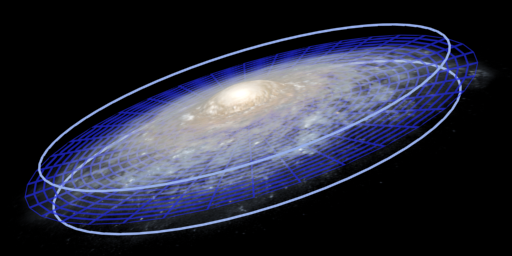
A schematic view of the galaxy.
The Inner Rim was a region of the galaxy between the Colonies and the Expansion Region. It was originally just called "The Rim", as it was expected to be the farthest extent of the known galaxy for centuries, but the Expanded Rim (later renamed the Expansion Region) was opened within a hundred years of the Inner Rim being settled during the Great Manifest Period. Inner Rimmers tended to see themselves as being part of the Core and looked disdainfully upon the "outer galaxy", but were known to resent and envy the greater wealth and history of the Core Worlds. The region had minimal cultural influence and had few truly notable planets beyond the ecumenopolis of Denon and the medical worlds of Manaan and Thyferra. As the bridge between the Core and the Rim, the Inner Rim held great strategic value, and during both the Clone Wars and the Galactic Civil War, brutal battles were fought over the region.
The Expansion Region began as an experiment in corporate-controlled worlds, known as the Exploitation Region, with powerful corporations exploiting and profiting heavily from the planets for their raw materials, metals and ores. Inhabitants were oppressed while the corporations stripped entire stellar systems along the Corellian Run of all their resources. The damage was so catastrophic that colonization shifted spinward to the Perlemian Trade Route, which was responsible for the conspicuous northern "bulge" of the modern Inner Rim's border. Colonization resumed during the Great Manifest Period, but the Alsakan Conflicts destroyed many of the Expansion Region's worlds in the Slice, shifting colonization west of the Corellian Run, creating a stretch of space known as the 77 Sectors that was dominated by Corellians for millennia. This part of the Expansion Region thrived, with the Rimma, Hydia, and Corellian Trade Spine Routes opening up the region and linking worlds like Tynna, the Gran homeworld of Kinyen, and trading planets of the Harrin Trade Corridor. This region's citizens often preferred to think of themselves as being apart from the rest of the luckless Expansion Region, which continued to suffer during the Republic's final millennium. A second, disastrous experiment in corporate control known as the Outer Expansion Zone ravaged the region and the resulting scandal forced the Senate to disband the Expansionist Oligarchy, but the final centuries of the Republic saw the Slice sectors of the Region fall into economic ruin. The story was told by the region's trade routes: while the Core, Colonies and Inner Rim were dense webs of tangled hyperlanes, the Expansion Region was ill-served by routes and the casual observer might think that it had never been settled. Expansion Region worlds continued to be producers of raw materials and ores. However, most natural resources were exhausted by the Imperial Period, with Gyndine, Bacrana and Cyrillia being among the few remaining viable ports.
With fewer natural resources (and therefore a smaller population) than many neighboring regions, the Mid Rim was a territory where residents worked hard for everything they had. Colonization began as the Expansion Region was settled, and while corporations continued to prefer to exploit that region, homesteading incentives and development grants from Coruscant were instead picked up by religious communes or local political confederations. The Slice in the Mid Rim was colonized slowly over several millennia, following a crosshatching pattern determined by Coruscant, giving rise to an orderly region whose residents had plenty of room to spread out. Corporate exploitation remained in the Expansion Region while lawlessness gravitated to the less-governed Outer Rim Territories, which were opened for colonization at the same time. Consequently, the Mid Rim built up a successful economy based on low-cost manufacturing and agriculture, and following the blazing of the Hydian War in 3693 BBY, the northern and southern arcs of the Mid Rim came into shape. Historic Republic outposts like Malastare or lost colonies like Naboo found themselves at the heart of new, orderly, government zoned settlement districts, some of which retained their alphanumeric identifications for centuries. Few of the Mid Rim's worlds became famous, but among those that did were the Wookiee homeworld of Kashyyyk and the Zabrak homeworld of Iridonia, the ocean planet of Glee Anselm, the Order of the Sacred Circle's retreat of Monastery, and Ansion, the nexus of several hyperlanes linked by the Keitumite Mutual Military Treaty.
The Outer Rim Territories was the largest region of the galaxy, and the last widely settled expanse before Wild Space and the Unknown Regions. It was strewn with obscure worlds, and rugged, primitive frontier planets. Due to its distance from the Core, government control was historically the weakest in the Outer Rim Territories, and it was the traditional refuge for dissidents, pilgrims and freedom-seekers, but it was also beset by lawlessness, oppression and violence. The worlds of the Outer Rim were immensely varied as a consequence: Eriadu was a prosperous, industrialised megalopolis, and Entralla was a vibrant, Human-dominated spaceport world, but Terminus and Aduba-3 were criminal-run shadowports, and Tatooine was a Hutt-controlled trade depot. The Outer Rim was also dotted with barely-habited worlds like Dagobah, Hoth, Tund and Muskree. Worlds closest to the major super-hyperroutes tended to be the most civilized, but far from these trade links, they tended to be dominated by the Hutts. Mass settlement of large portions of the Outer Rim did not begin until after 5500 BBY, when colonists took advantage of the new trade routes of the Hydian, the Rimma, and the Corellian Trade Spine. Settlement in the southern quadrant was rapid, but expansion in the northern quadrant was hampered by the Great Galactic War and the horrors of the Kanz Disorders. In a reversal of the galaxy's usual pattern, colonization was slowest in the Slice, dominated as it was Hutt Space. Republic authority in the region all-but collapsed during the New Sith Wars, and arguably never returned, with the Hutts filling the power vacuum and piracy, slavery and anarchy dominating. In 124 BBY, the Senate declared the whole region a Free Trade Zone in an effort to jump-start economic development, but this was exploited by the Trade Federation, and the Senate re-imposing taxation in 33 BBY was the trigger for the Invasion of Naboo and the Separatist Crisis. The Galactic Empire oppressed much of the Outer Rim, leading to greater sympathy for the Alliance to Restore the Republic in the region, but the New Republic and the Galactic Alliance both failed to impose central control in the area, leaving the Outer Rim much as it had been for centuries.
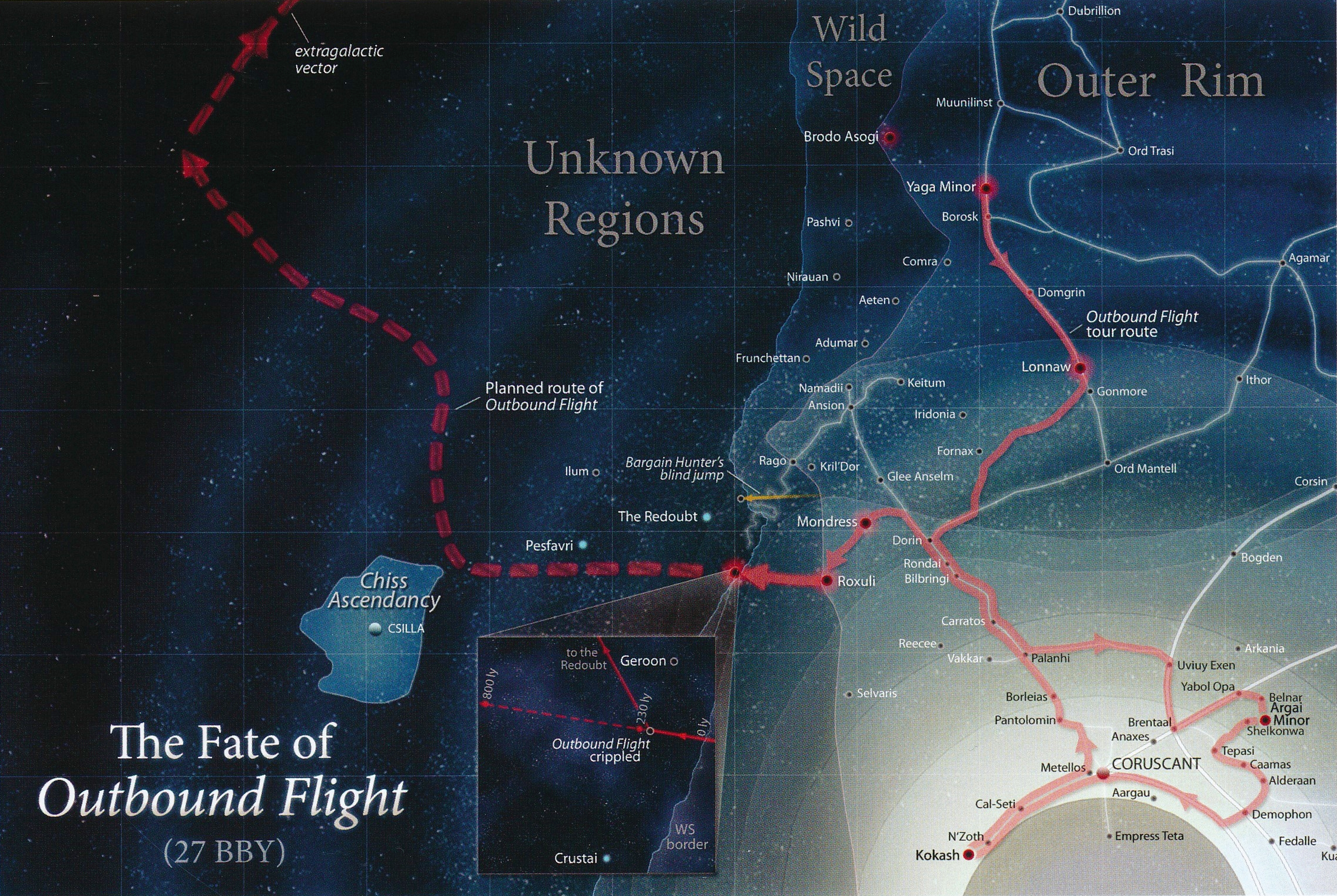
Part of the Unknown Regions, showing the of the Chiss Ascendancy and the planned route of the Outbound Flight .
The term "Unknown Regions" referred to those areas that had not been directly surveyed by Republic or Imperial scouts. It was most commonly applied to the less-known parts of the galaxy's western disk, a quadrant stretching roughly between Bakura and the Imperial Remnant. However, the term also applied to the galaxy's halo of gas, dust and stars, as well as the satellite galaxies. When the aggregate of all this territory is summed, the Unknown Regions reached nearly triple the size of settled space, but by some calculations, just 15% of the galactic disk's total stellar mass qualified as part of the Unknown Regions. The chunk of the Unknown Regions within the galaxy was a product of the lack of any western analogues to the Perlemian Trade Route and the Corellian Run, and the Republic's early scouts were content to expand into the easier-to-reach territories of the Slice. It later became clear that the route to the west was in fact barred by a tangle of hyperspace disturbances that effectively split the galaxy in half, forming the midline of the galactic barrier that enveloped the galaxy. The barrier to the Unknown Regions was permeable, however, with spacer tales telling of strange ships visiting distant Outer Rim ports like Terminus, hyperdrive mishaps taking ships through the divide, or ancient alien trails allowing access to the region.
The ill-fated Outbound Flight Project was one of the first official attempts to penetrate the Unknown Regions, while the Galactic Empire's Grand Admiral Thrawn spent several years mapping portions of the area. The Chiss were the dominant species of the Unknown Regions, but in comparison to known space, where most amoral or expansionist species were cowed or exterminated by the early Republic, the Unknown Regions were still a savage, anarchic area. Other powerful species within the region included the slaver empire of the Vagaari, the illusion-spinning mollusks called Crokes, the religiously-fanatical Ssi-ruuk, and the blind berserkers of the Leech Legion. Outside the disk, in the satellite galaxy of Companion Besh, lived the Nagai and their oppressors, the Tofs. The Nagai invaded known space in 4 ABY, pursued by the Tofs, and joined forces with the Alliance of Free Planets to defeat their oppressors and returned to Firefist to liberate it.
Normalization of relations with the Chiss Ascendancy after the Yuuzhan Vong War led to the establishment of stable hyperroutes into the Unknown Regions through the Utegetu Nebula, such as the Rago Run, and by 44 ABY the name was largely inaccurate, at least when applied to the galactic disk. The galactic halo and the satellite galaxies, however, remained poorly explored and mysterious.
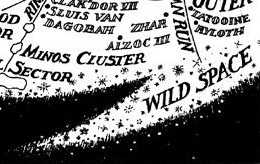
By 0 BBY, Wild Space often referred to the southeast of the galactic disk.
Wild Space was the frontier of galactic society and was not a formal label, but was applied to the unsettled galactic fringe and other parts of the galaxy with negligible colonization or development. Wild Space by the Imperial Period typically referred to the wispy fringe of the galaxy's eastern disk, as well as the narrow, meandering strip that separated the civilized galaxy from the Unknown Regions. One of Emperor Palpatine's last acts was to open up much of the region to more extensive exploration. Wild Space differed from the Unknown Regions in that some of Wild Space had been explored, though not extensively, and the findings recorded in official logs; the Unknown Regions remained mysterious. The worlds of Wild Space largely ignored the central government, and were generally peaceful, but many acted as criminal hideaways.
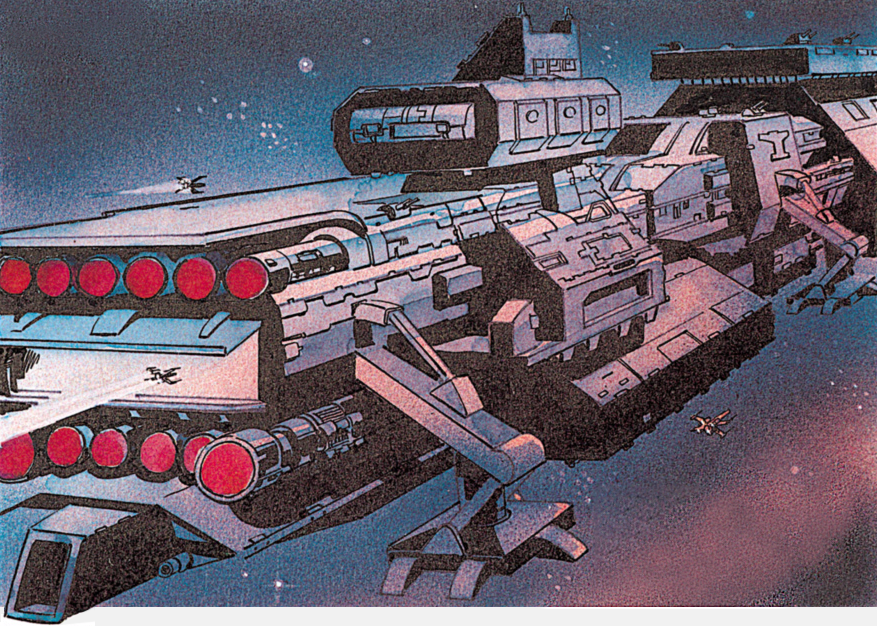
An Imperial shipyard in the Galactic Rim.
The Galactic Rim was located on the edge of the galaxy and was remote to most civilisation and much was not known about it. The Galactic Rim was slightly less luminous as the stars faded out. However, the Galactic Republic was fully aware that the Yuuzhan Vong had established a foothold in the edge of the galaxy. With the Galactic Empire having a vast shipyard there, that would then be used by the Dark Empire.
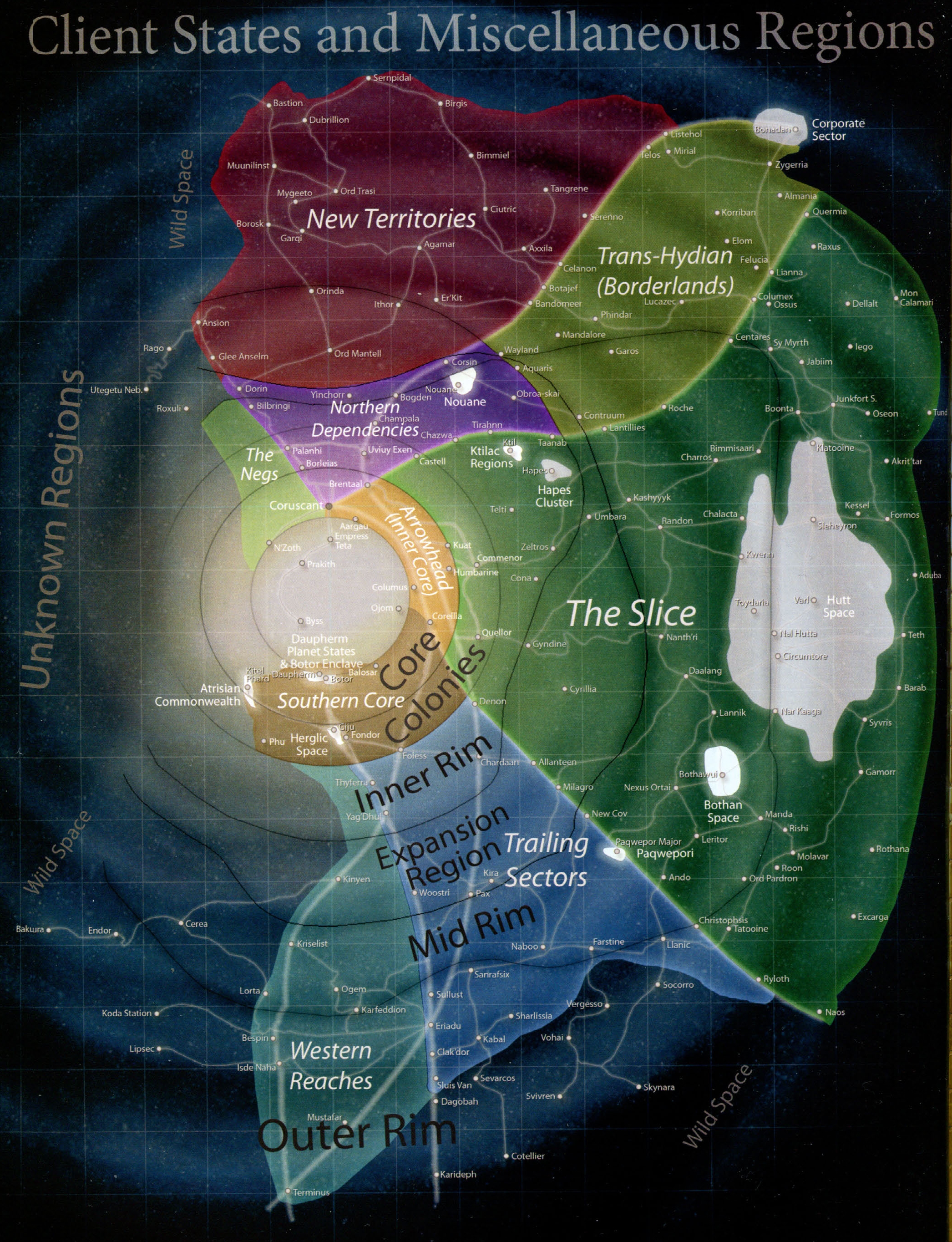
Map showing the galaxy's main regions, miscellaneous smaller territories, and client states and Allied Regions.
The galaxy's ten main regions did not reflect the full reality of its political and cultural divisions. Within the territorial bands between the Core and the Outer Rim lay a number of groupings and prefectures, some that had their own regional governments, and others that had only shared cultural stereotypes. The largest of these was the Slice, a vast region of space between the Perlemian and the Corellian Run generally considered the center of galactic civilization and commerce. At its tip was the Arrowhead, encompassing the Core Worlds part of the Slice, with Coruscant at its point. The Arrowhead's other two vertices traditionally fell on Vento on the Perlemian and on Corellia itself, on the Run. The Arrowhead contained the elite of the Core Worlds, and grew out of the ancient pre-Republic Tetrahedron that was the cradle of galactic civilization. Sometimes called the Inner Core, the Arrowhead included Ixtlar, Alsakan, Grizmallt and Anaxes, which became ever-more prestigious the closer they were to Coruscant.
Colonists out of the Arrowhead settled the Slice, going out into what became known as the Colonies, and then further beyond. The worlds along the Perlemian and the Corellian Run were settled for millennia, and colonization slowly reached out from both to knit the Slice together. The Core, Colonies and Inner Rim portions of the Slice were thickly-settled and crisscrossed with thousands of hyperlanes and praediums; the Expansion Region was heavily-colonized near the Corellian Run (and dominated by Corellian interests), but more sparsely settled south of the Perlemian, the product of the millennia-long Alsakan Conflicts. The Slice's luster had begun to fade by the time colonists pushed beyond the Expansion Region in the central Slice; the Mid Rim reaches were well-surveyed but thinly-settled, and the Hutts dominated the Outer Rim precincts even beyond Hutt Space. Though new industries and businesses had largely moved beyond the Slice by the time of the Clone Wars, the region was still considered the heart of galactic civilization, a distinction its citizens remained proud of.
The Southern Core was settled from the Arrowhead and grew through contact with a number of advanced ancient civilizations, including the Devaronians, the Herglics, and the Atrisian Commonwealth. This made it a polyglot region that resisted easy characterization. The western quadrant of the Core Worlds long resisted exploration, lacking any super-hyperroutes and limiting progress along hyperlanes like the Metellos Trade Route to one- or two-light-year hops. Worlds settled along this western frontier received a negative first digit in their galactic coordinates owing to their position west of Coruscant, earning them the name "the Negs," dooming such areas as the Farlax sector to perennial second-class status within the Core.
The Northern Dependencies, a long-settled region north of Coruscant, generally looked outward, whether to Nouane, the worlds of the Hydian Way, or the New Territories beyond. Some of the galaxy's greatest traders, explorers and entrepreneurs hailed from the Northern Dependencies, and the region included some of the galaxy's eldest worlds, rarely troubling itself with Core World politics. To its northeast, the region north of the Perlemian Trade Route, was the Trans-Hydian, an area dotted with worlds with ancient histories, such as Mandalore or the planets of the Sith Worlds and the Tion Cluster, but largely sidelined economically until late in galactic history. Economic development jumped from the Slice to the Trailing Sectors further south, and then followed the Hydian Way into the New Territories. For millennia, the threat of the Mandalorians, rumors of the ancient Sith, and geographic oddities such as the vast Radama Void encouraged more profitable enterprises elsewhere. The Trans-Hydian owed its name to traders from Ord Mantell and Celanon, who braved the threat of Mandalorian raiders to blaze new trade routes like the Listehol Run, the Shaltin Tunnels and the Gordian Reach to link the Hydian and the Perlemian. After the Battle of Endor, the region's loyalties were split between the Empire and the New Republic, earning it the name of the Borderland Regions.
The Trailing Sectors were settled during the Alsakan Conflicts, which saw many colonies in the Slice ruined, enslaved or depopulated, pushing colonization west of the Corellian Run. Here, intrepid traders had long done business with the Herglics, Givin and Tynnans, and the Expansion Region's Trailing Sectors soon outstripped the Slice sectors, jumpstarting expansion into the Mid Rim. The rise of the Rimma Trade Route in 5500 BBY and the Hydian Way two thousand years later furthered this long boom, knitting the region together for traders from across the galaxy. Denizens of the Trailing Sectors tended to view their region as having built on the successes and traditions of the Slice while disregarding its mistakes, valuing entrepreneurship and and hard work.
The Western Reaches grew up around the Corellian Trade Spine and the Hydian Way, with settlement flowing in from the Southern Core and the Trailing Sectors and inheriting those regions' diversity and sense of independence. Explorers and settlers continued to expand the region as late as the period of the New Republic, pushing further west into the Unknown Regions. The Reaches' independence and distance from Coruscant historically made them a hotbed of rebellion, being the refuge for the last holdouts of the Confederacy of Independent Systems after the Clone Wars. The Galactic Empire launched a massive campaign to pacify the Western Reaches, but the area remained a refuge for the Alliance to Restore the Republic throughout the Galactic Civil War and was the site of many Imperial atrocities.
The New Territories were beyond the Northern Dependencies in a region that had developed slowly in contrast to much of the galaxy. Worlds such as Ithor, Ord Mantell and Iridonia were well known, but they were isolated outposts. Large-scale efforts to promote settlement in the northern quadrant repeatedly failed, leading to disasters like the Kanz Disorders and the Outer Expansion Zone. The region was finally properly settled in the final years of the Republic, with the D'Asta merchant family of Serenno establishing markets along the Braxant Run while the Nalroni Merchant Council expanded along the Celanon Spur. These economic successes encouraged Coruscant to invest heavily in the region, soon dubbed the New Territories, and between Republic spending on programs like the Planetary Pioneers and the influence of the D'Asta family, the region was strongly Loyalist during the Clone Wars and the Galactic Civil War. The New Territories was the core of many Imperial successor states after the Battle of Endor, and it became the contested frontier between the New Republic and the Imperial Remnant. The New Territories were devastated during the Yuuzhan Vong War, and struggled to rebound afterwards.
Some thirteen billion years before the Battle of Yavin, an immense cloud of gas and dust collapsed under its own gravity and coalesced to form a revolving disk, creating the galaxy. Over many more billions of years, the stars and planets began to form. By 5,000,000,000 BBY, life had begun to evolve in the galaxy, with some of the earliest examples of non-sentient life developing on Goroth Prime.
Around 2,000,000 BBY, many of the galaxy's most well-known species were evolving: the Wookiees began on Kashyyyk as a species of tree-climbers. The Oracle of Pelgrin, quite possibly the oldest artifact in the galaxy, was believed to date from this period. By 200,000 BBY, the Zhell, ancestors to the Humans, had developed intelligence and were waging war against the Taungs for control of their mutual homeworld of Notron, later known as Coruscant.
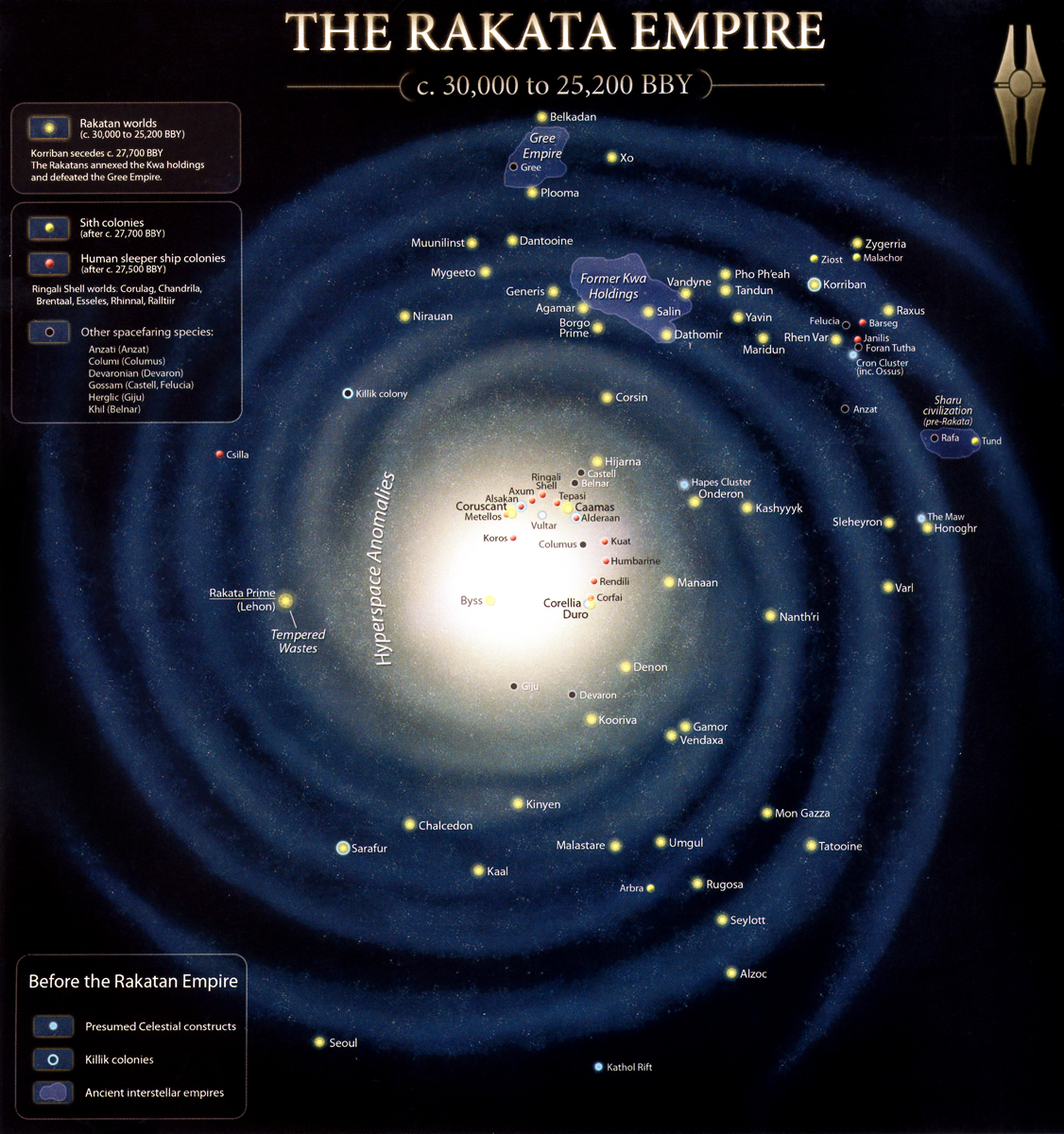
The galaxy under the Rakatan Infinite Empire.
By 100,000 BBY, a mysterious race known as the Celestials dominated the galaxy. Also known as the Architects, this spectacularly powerful race was believed to have been capable of manipulating and moving the very stars: surviving Celestial machinery like Centerpoint Station and the Cosmic Turbine could manipulate gravity on a titanic scale with repulsor pulses, tractor beams, and hyperspace wormholes. With this technology, the Celestials were believed to have been responsible for building the Corellian system, the Vultar system, and 15 other star systems, as well as the Hapes Cluster, the Kathol Rift, and the Maw black hole cluster. Pre-Republic specialists believed the Celestials to also be responsible for the circumferential hyperspace barrier, possibly as a defense against outside interference. They were also believed to be responsible for the chain of hyperspace anomalies west of the Core that bisected the galaxy and prevented travel into the Unknown Regions. Speculation holds that the Celestials had crafted the hyperspace anomalies that bisected the galaxy in order to contain the Rakata.
A number of other spacefaring races around this time became clients of the Celestials. The insectile Killiks of Alderaan were exploited as laborers and were seeded across the galaxy, until around 30,000 BBY when they disappeared into the west of the galaxy and into the Unknown Regions, presumably relocated by the Celestials. The Kwa and the Gree made use of structures known as the Infinity Gates and hypergates, respectively, to travel between planets and came into territorial conflict with each other. Other species fled to escape the Celestials: the Sharu of the Rafa system far in the galactic east had a brief period of expansion, spreading their iconic plastic pyramid cities as far into the Core as Aargau, but this may have attracted the attention of the Celestials and the Sharu buried their cities and sought refuge in primitivism to escape them. Likewise, the Columi of Columus made surveys of both the Humans and the Duros in the Core and were unimpressed by what they found, but also fled back to their homeworld, perhaps to avoid retribution from the Celestials.
A cosmic war was fought at one time in the galaxy's past. Around 35,000 BBY, the domain of the Celestials was usurped when the Rakata slave race revolted. Stealing technology from the Kwa, they waged war against the other servant races, and broke through the barrier surrounding the Unknown Regions into the galaxy proper and waged a war of extermination upon the Celestials. The eventual fate of the Celestials was unclear. They may have been trapped inside the galaxy by their barrier and destroyed by the Rakatan revolt, or they may have escaped through the barrier. By 30,000 BBY, the Celestials were nowhere to be found, and the Rakatan Infinite Empire had taken center stage.
The Rakata fanned out from their homeworld of Lehon in the Tempered Wastes of the Unknown Regions, using hyperdrives that channelled the power of the Force to guide them to worlds with strong Force signatures. The Infinite Empire occupied a scattering of systems across the galaxy, but vast tracts of territory between these holdings remained untouched, allowing smaller interstellar confederations to flourish. The Devaronians and the Gossam experimented with the tumble hyperdrive, and while worlds like Coruscant, Corellia and Duro were occupied by the Rakata, Humans, Duros, Selonians and Drall were able to study the principles of the Rakatan hyperdrive. The Rakata proved to be cruel masters, consigning entire subject populations to slavery. After nearly five thousand years of dominance, the Rakatan Empire collapsed after a devastating plague swept through the Empire that stripped the Rakata of their ability to use the Force. A colonial slave revolt finished off the empire by 25,200 BBY.
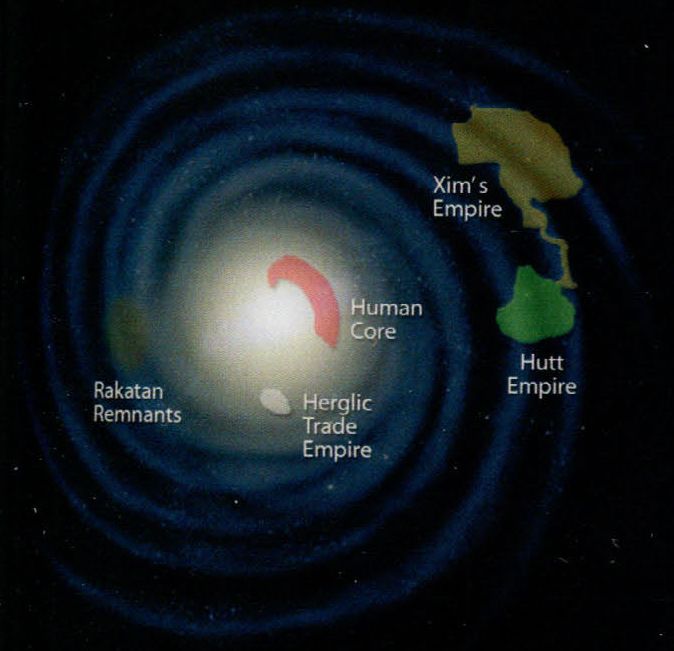
The post-Rakata galaxy, showing the Human Core around which the Republic was formed, the Hutt Empire, and Xim's empire.
The decline of the Infinite Empire coincided with the reverse-engineering and perfection of Rakatan hyperdrive technology by the other species of the galaxy. Developing technological replacements to its Force-based components, various species struck out from their homeworlds, first with slower-than-light sleeper ship colonies, followed by the development of the hyperspace cannon. Through this re-use of Rakatan castoffs, a number of civilizations asserted themselves: the Humans and Duros dominated the Core, while the cetacean Herglics built up their own trade empire to the south. On the Rim, Human sleeper ship colonies formed the Tionese civilization, which was united into an empire by Xim the Despot, before coming into conflict with the empire of the Hutts.
This period coincided with the beginning of the Jedi Order on Tython with its studies of the Force, as well as the religious rivalry between understandings of the light and dark sides of the Force. Conflict between the Jedi and the Dark Jedi would assert itself several times throughout galactic history, a cycle that continued beyond the Yuuzhan Vong War.
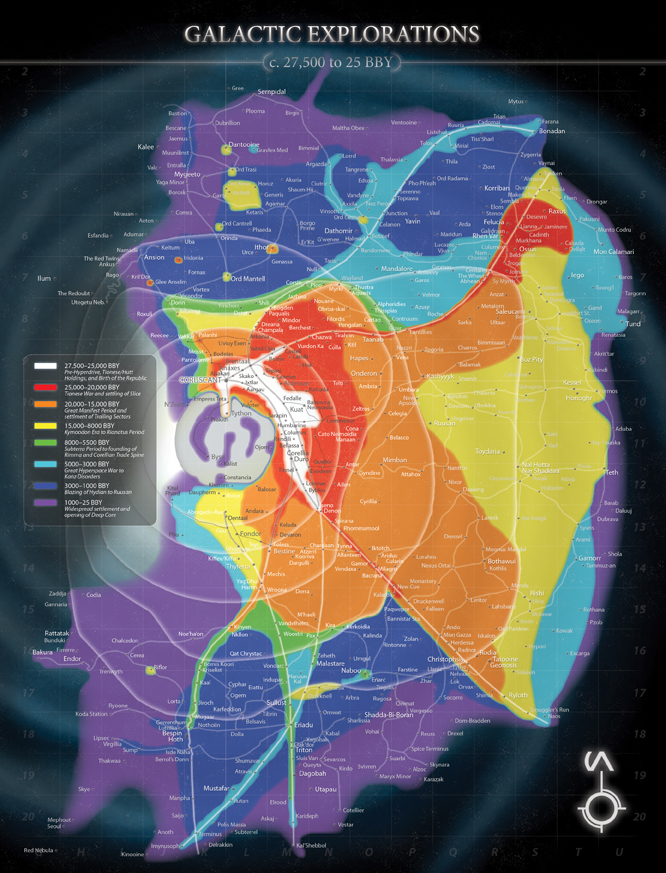
A map of the progress of the exploration of the galaxy.
In 25,000 BBY, in the aftermath of the Unification Wars, the various states of the Core assembled on Coruscant and signed the Galactic Constitution, establishing a civilization under a common law, language and currency, proclaiming the Galactic Republic. The Republic united the largely-Human Core Worlds, and the Core Founders included political players like Coruscant, Alsakan, Corellia, Duro, Kuat and Alderaan, military strongholds like the Azure Imperium of Axum and Anaxes, as well as Esseles and Rendili, emerging commercial hubs like Tepasi, Brentaal IV and Humbarine, and worlds important to the medical, diplomatic and philosophical arts, like Chandrila, Caamas, Rhinnal and Shawken.
The Expansionist Era coincided with the foundation of the Republic and saw the beginnings of the official charting and settlement of much of the galaxy's spiral. Scouts pushing east from Coruscant moved up two trade routes, the Perlemian Trade Route and the Corellian Run, which formed the boundaries of a vast wedge of space known as "the Slice." At the end of the Corellian Run lay Kalarba, a trade hub maintained by the merchants of Paqwepori, while the Perlemian led to the trade worlds of Tirahnn, Nouane, and Roche. No similar corridors were found to the galactic west, which resulted in much of that quadrant of the galaxy remaining unexplored and mysterious, becoming known as the Unknown Regions. This expansion saw the Republic come into conflict with the Human civilizations of the Tion Cluster. After its victory in 24,000 BBY, the Republic swelled with more territory than it could initially govern as many systems clamored for protection against the depredations of the Hutts.
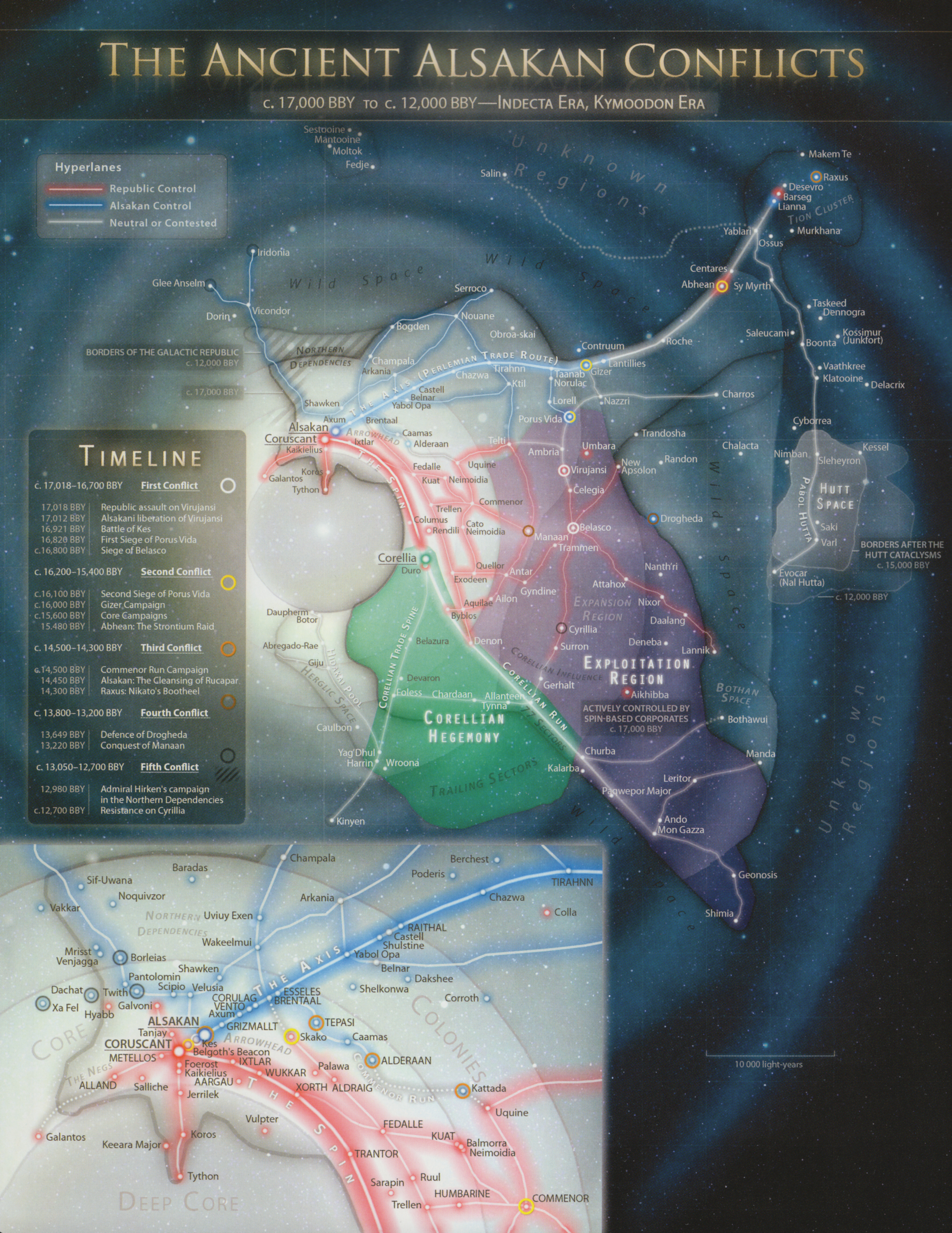
The galaxy from the Indecta Era to the Kymoodon Era.
The Great Manifest Period began in 20,000 BBY with the widespread settling of the Slice, with the dense web of systems at its tip becoming known as the Arrowhead. This region became heavily-dominated by Coruscant while Corellia dominated settlement around the Corellian Run. Rivalry between Coruscant and Alsakan over policy on the Perlemian sparked the First Alsakan Conflict in 17,000 BBY, the start of the Indecta Era, and though peace would be brokered between the two, the Alsakan Conflicts would continue in an abbreviated form for some 14,000 years. The first five Alsakan Conflicts also discouraged settlement along the Perlemian, pushing colonists to the Corellian Hegemony in the Trailing Sectors along the Corellian Run and the growing Corellian Trade Spine.
The Kymoodon Era, opening in 15,000 BBY, ushered another colonization boom on par with the Great Manifest Period. Improvements in the hyperdrive allowed many odd pockets of colonization to spring up in the unexplored northern and southern quadrants, and the Herglics joined the Republic, beginning a surge in development around the Hidakai Pool, which would become the Rimma Trade Route. However, the era stored up the seeds for future conflict, as the Republic's borders increasingly abutted those of Hutt Space, leaving isolated colonies open to raids by Hutt slavers. Widespread resentment of the Hutts on the Rim was tapped by Contispex I and the Humanocentric Pius Dea religious sect to begin a series of Crusades against the Hutts in 12,000 BBY. The millennia-long Pius Dea Era would see many non-Human species conquered, persecuted, or exterminated until the Contispex dynasty was overthrown by the Jedi Order, and would foment extreme resentment among the species of the Rim. The subsequent Ductavis Era and Rianitus Period from 11,000-8000 BBY would be periods of retrenchment and rebuilding following the Crusades.
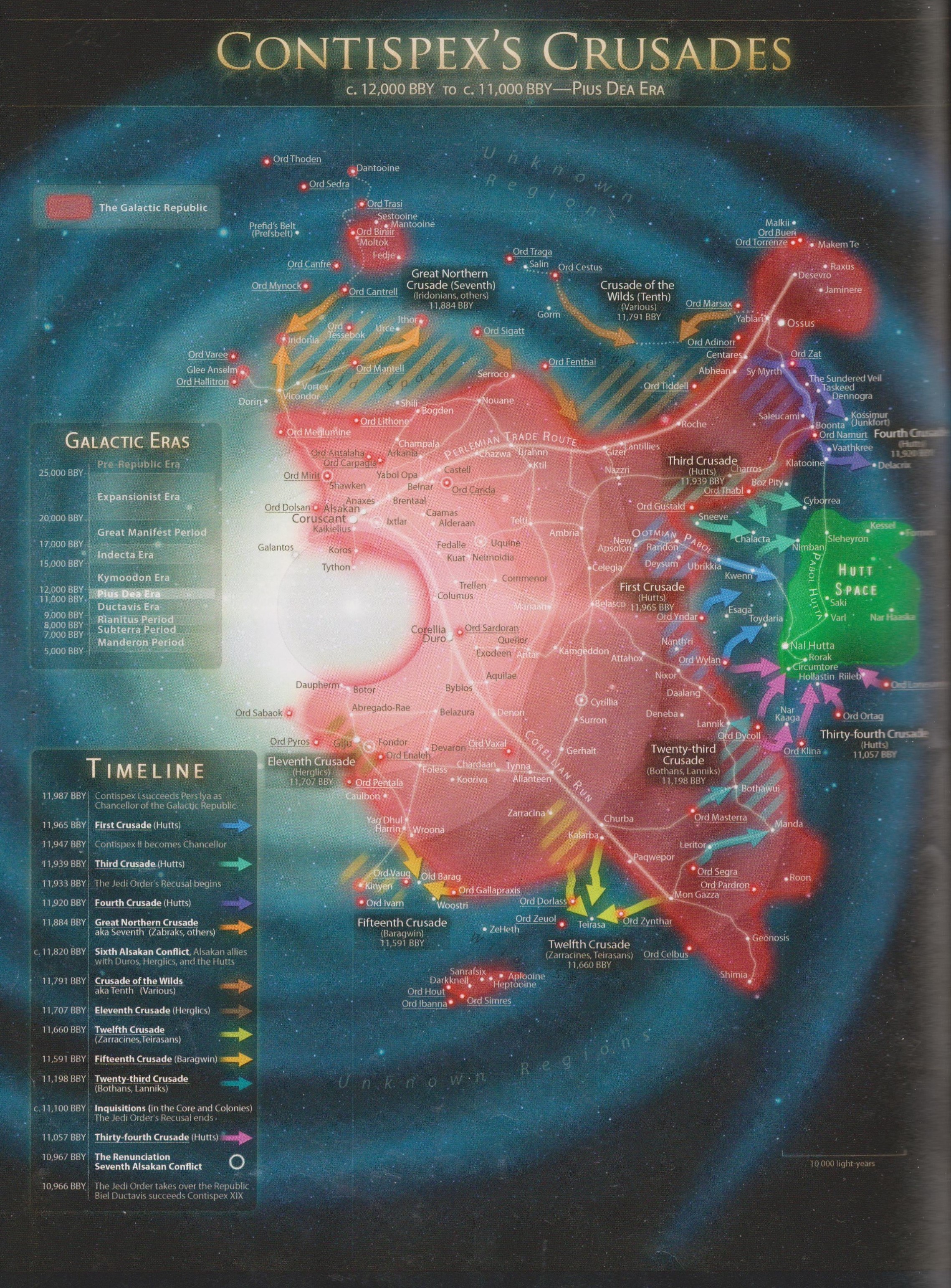
The galaxy during the Pius Dea Era.
The Subterra Period of 8000-7000 BBY saw new mapping of the galactic southern quadrant, with colonies such as Malastare serving as anchors for the tangles of praediums that linked the region. Scouts also penetrated the Rishi Maze around this time. However, the lack of a super-hyperroute into the southern quadrant and the new colonies' general inaccessibility promoted lawlessness in the Rim and limited Coruscant's authority, which was believed to have contributed to the Second Great Schism of the Jedi Order in 7003 BBY, beginning a galaxy-wide uprising of Dark Jedi known as the Hundred-Year Darkness. In the war's aftermath, the defeated Dark Jedi were exiled beyond the Rim into the unexplored space north of the Perlemian. There, the Exiles settled the worlds of Korriban and Ziost within the Stygian Caldera, where they dominated the native Sith and established an empire.
During the Manderon Period, the Corellian Trade Spine and the Rimma Trade Route were established in 5500 BBY after the Herglics, Givin and Corellians linked together hundreds of pre-existing praediums, improving access to the southern quadrant. In 5000 BBY, the Sith Empire was rediscovered by the Republic, beginning the Great Hyperspace War when the Sith Lord Naga Sadow attempted to conquer the Republic. The Sith were defeated and once again driven into exile, but it was the beginning of a threat that would trouble the Republic for the remainder of its existence. A thousand years later in 4000 BBY, Sith teachings discovered on Korriban and Onderon enticed the Jedi Exar Kun and Ulic Qel-Droma to the dark side, beginning the Great Sith War. The Sith's alliance with the Mandalorians, a group of warrior-nomads descended from the Taungs, in that war would prove to be the genesis of another threat to the Republic with the Mandalorian Wars. The Republic endured nearly fifty years of almost continuous fighting known as the Old Sith Wars as a result of Exar Kun until the Sith Empire was destroyed in 3950 BBY by the redeemed Sith Lord Revan.
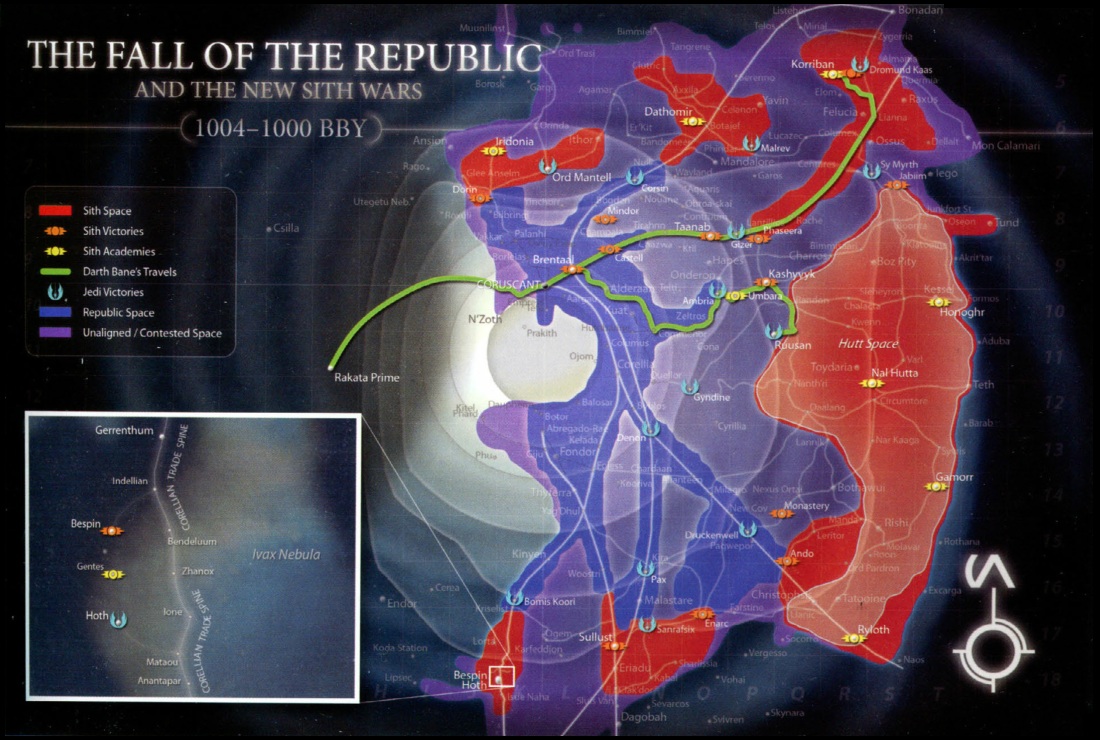
The galaxy during the final years of the Draggulch Period.
By 3700 BBY, the galaxy had been charted and settled as far as Farana in the north and Malastare in the south, but much of the northern and southern quadrants beyond the trade routes remained unsettled. At that time, however, the Brentaal-born explorer Freia Kallea extended the ancient Brentaal–Denon Route and linked several pre-exisiting praediums. By 3693 BBY, she had expanded the trade routes south of Denon as far as Imynusoph, mapping the full length of the Hydian Way, the only super-hyperroute to span the length of the galaxy. The ease with which vessels could now reach the northern and southern quadrants greatly expanded the Republic's footprint into the New Territories and the Western Reaches and opened up countless new sources of minerals, crystals and gases. From 3681-3642 BBY, however, the Republic endured decades of war and tension with a resurgent Sith Empire formed by exiles from the Great Hyperspace War, led by the Sith Emperor Vitiate. A second Galactic War broke out between the two in 3642 BBY, and chaos reigned until the Sith Emperor's redoubt of the Eternal Empire was defeated.
In the wars' aftermath, the galaxy enjoyed several centuries of relative prosperity, which ended in 2000 BBY with the dawn of the Draggulch Period and the start of the New Sith Wars when the Jedi Master Phanius proclaimed himself Darth Ruin. In the ensuing millennium of fighting between the Republic and the New Sith, the Republic almost collapsed, culminating in the Republic Dark Age in the final century, when the Republic's authority effectively ceased to exist beyond the major trade routes and the HoloNet communications network ceased to function. The New Sith Wars finally ended when the Army of Light led by the Jedi Lord Hoth defeated Skere Kaan's Brotherhood of Darkness at the Seventh Battle of Ruusan. A single Sith Lord, Darth Bane, escaped to establish a new Sith order, while Supreme Chancellor Tarsus Valorum proclaimed the Ruusan Reformations, which rebuilt the Republic from the ground up.
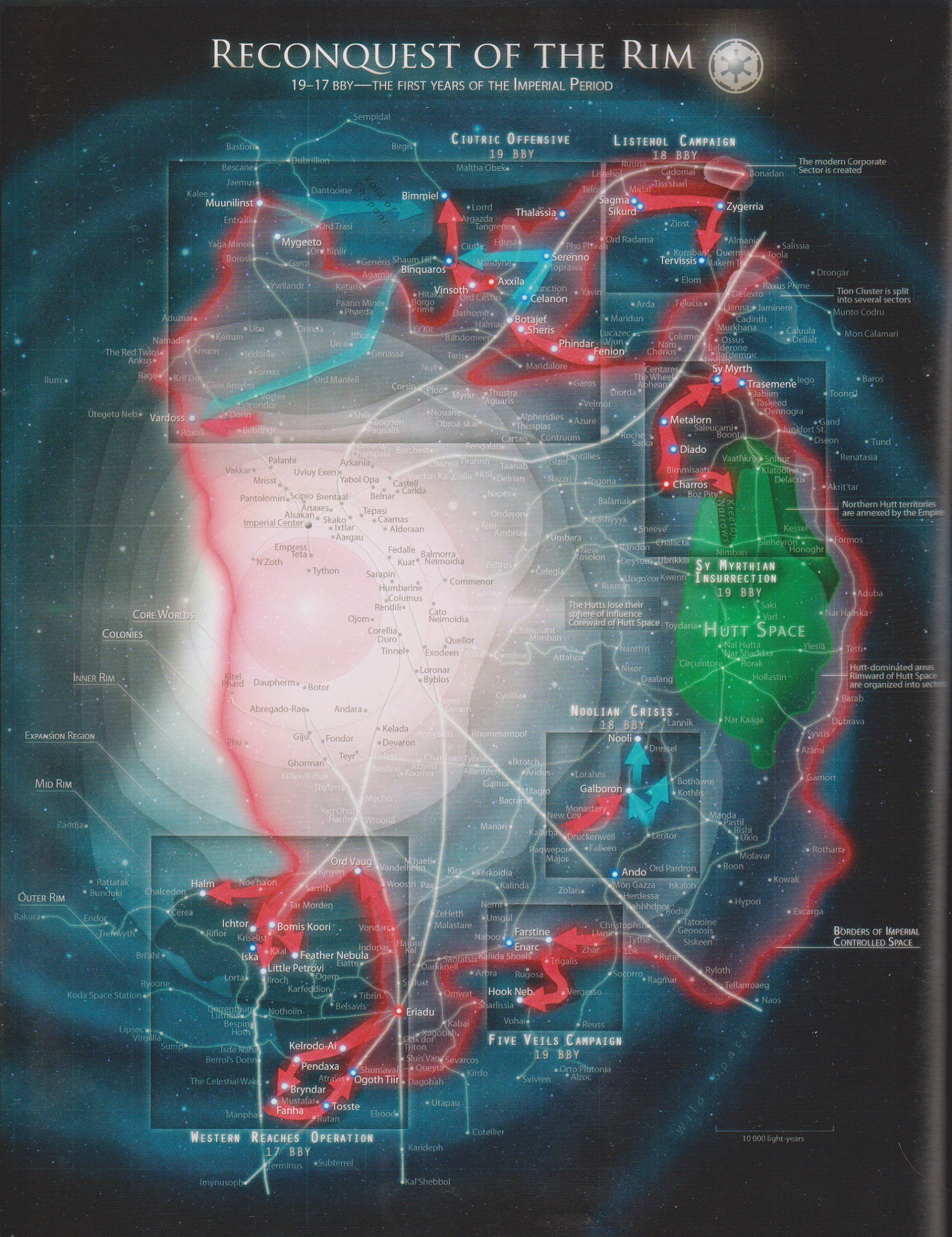
The galaxy during the early years of the Imperial Period.
The Republic's final millennium was largely peaceful, but the provisions of the Ruusan Reformations led to an increase in lawlessness in the Outer Rim Territories, which eventually found itself largely controlled by megacorporations or criminal cartels. This dissatisfaction was stoked into a Separatist movement by the Sith, which had spent a millennium in hiding. Orchestrating the Clone Wars, the Order of the Sith Lords managed to destroy the Jedi Order and restore their Empire under Darth Sidious. Sidious dissolved the Republic and replaced it with the short-lived Galactic Empire, and eventually dissolved the Republic's trappings completely. A legacy of Imperial rule was the opening and widespread settlement of the Deep Core, as well as the charting and exploration of much of the Unknown Regions. The Empire lasted for two decades of tyranny, but after the Galactic Civil War and the death of Darth Sidious at the hands of Anakin and Luke Skywalker, a New Republic was established from an alliance of free worlds. Despite this, the remnants of the Empire would continue to resist the new government for over a decade before finally signing a peace treaty.
The Yuuzhan Vong War was a watershed moment in galactic history, marking the first time that the galaxy had been invaded by an extra-galactic power, and the savagery of the war would influence galactic politics for over a century afterwards. Not long after the conclusion of the Galactic Civil War, an extra-galactic species known as the Yuuzhan Vong launched an invasion of the galaxy. The Yuuzhan Vong War devastated much of the galaxy, including Coruscant, and cost the lives of some 365 trillion beings, though they were eventually defeated by a new Galactic Alliance of the Imperial Remnant, the remnants of the New Republic, and a host of the galaxy's lesser powers. Another outcome of the war was a normalisation of relations between the galaxy proper and the Chiss Ascendancy, the dominant power of the Unknown Regions. Within a few decades, stable hyperroutes and colonies had been established into the region and had removed much of its mystery.
Some of the Yuuzhan Vong were incorporated in the galactic community, but the post-Yuuzhan Vong War galaxy proved incredibly difficult to govern, resulting in a Second Galactic Civil War between the Galactic Alliance and a Confederation led by Corellia. Within a century, the Galactic Empire had been restored under the Fel dynasty, although this time without Sith backing. Ultimately, however, the Fel Empire was manipulated by the One Sith, led by Darth Krayt, to declare war upon the Galactic Alliance after the Sith exploited lingering hatred of the Yuuzhan Vong to to make it appear that they were planning to re-conquer the galaxy. The One Sith usurped the Imperial throne shortly afterwards, forming a new Sith empire, but the resulting war between the Sith and the Galactic Alliance Remnant and the Fel-loyalist Empire-in-exile resulted in the Sith's defeat. Thereafter, the Galactic Alliance became the dominant government in the galaxy once again.
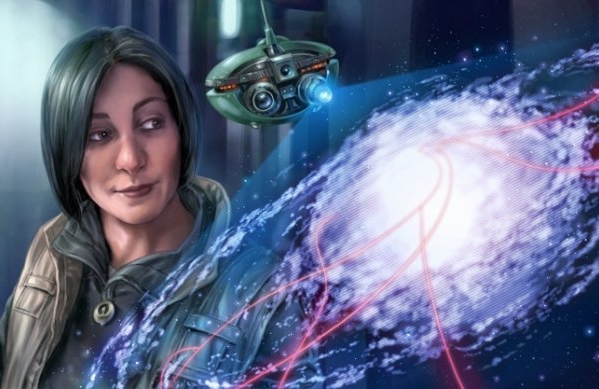
Corellia Antilles views a hologram of the galaxy with its major trade routes highlighted.
Clear and stable paths through hyperspace, known as hyperlanes or hyperroutes, were the essential bedrock of galactic civilization. Hyperlanes provided safe trails for starships around the dangerous gravitic "mass shadows" left in hyperspace by objects in realspace. These routes were explored and established by spacers known as hyperspace explorers such as like Aitro Koornacht and Jori and Gav Daragon. Following are noteworthy routes that had shaped galactic history.
The super-hyperroutes were the largest, longest and fastest hyperlanes in the galaxy, with several stretching from the Core Worlds all the way to the edge of the Outer Rim. The two oldest were the Perlemian Trade Route and the Corellian Run, both blazed after the development of the hyperdrive in 25,000 BBY. The Perlemian formed the northern border of the Slice and linked the galactic capital of Coruscant to the Jedi training world of Ossus and the civilizations of the Tion Hegemony. Early in the Republic's history, colonies and species along the breadth of the Perlemian appealed for Republic protection from the Tionese or the Hutts, fuelling the quick expansion of the young Republic. The Perlemian, known poetically as "the Axis", was dominated by Alsakan early in the Republic's history, beginning the socio-economic divide that fuelled the Alsakan Conflicts. The Perlemian emptied into Wild Space at the galaxy's fringe beyond Quermia.
The Corellian Run ensured the economic dominance of Corellia within the emerging Republic and formed the southern border of the Slice. The portion of the Run Coreward of Corellia, known as "the Spin," was dominated by Coruscant early in the Republic's history, forming the divide with the Spin and Alsakan. Rimward of Corellia, however, Corellians and Humans of Corellian descent dominated and held substantial economic power in the sectors surrounding the Run for millennia afterwards. With the two eldest hyperroutes quickly established, it was much easier to explore in and around the Slice, causing a population boom that accounted for the galaxy's settlement patterns.
The Corellian Trade Spine was established in 5500 BBY, although the first led existed as far back as 25,000 BBY, linking Corellia and Duro. The Trade Spine intersected the Rimma Trade Route at Yag'Dhul before extending Rimward to the Greater Javin and past Terminus. While offering rapid transit into the galactic southern quadrant, the Corellian Trade Spine never provided the same economic benefits as the Rimma Trade Route. Established around the same time, the Rimma was plotted by Givin hyperspatial cartographers and blazed by Sullustan scouts out of Herglic Space. The Rimma helped usher in widespread colonization of the southern quadrant and enriched the worlds of the Tapani sector in the Colonies. Significant planets on the Rimma included the rich industrialized world of Eriadu on the junction with the Hydian Way, the Bith homeworld of Clak'dor VII, and the shipyards of Sluis Van.
The last super-hyperroute to be established, the Hydian Way, was the only one to span the entire length of the galaxy. Created almost entirely due to the efforts of the Brentaal-based scout Freia Kallea, around 3700 BBY she extended the ancient Brentaal–Denon Route east, linking several obscure routes into a single passage that extended to the northern quadrant's galactic edge. She then pushed south of Denon, blazing new routes to the Rim of the galaxy in the southern quadrant and opening great swaths of space to new colonization.
The Metellos Trade Route was oriented west of Coruscant into the Negs as a failed attempt to discover a western analogue to the Perlemian Trade Route. Initially promising, its expansion stalled in the face of the hyperspace eddies close to the Unknown Regions, and explorers were able to extend its length only a few light-years each century until it eventually terminated in the Farlax sector. A more successful Core Worlds hyperroute was the Koros Trunk Line, an ancient pre-Republic route linking Coruscant to the carbonite mines of the Koros system. Carbonite was essential to keeping the passengers of sleeper ships in suspended animation, and the route carried so much ore after the development of the hyperdrive that it became known as the Carbonite Pipeline.
The Salin Corridor was one of the oldest hyperlanes in the Outer Rim, first forged by Xim the Despot's empire as the Warrior's Trace to support his wars with the Hutts, and maintained by a "lighthouse network" of jump beacons. While many of the Xim-era beacons had long-since vanished, the stability of parts of the Salin Corridor was unusual and had intrigued hyperspace theorists for millennia. One of the longest routes in the Outer Rim, it began amid the Hutt-controlled Rim worlds near Aduba, meandered Coreward around the tip of Hutt Space, before turning north into the edges of the Tion Cluster. From there it skirted the Radama Void, intersected the Hydian Way at Botajef, and emptied in the northern quadrant.
The Braxant Run was the northern quadrant's most important route, beginning at Bandomeer on the Hydian and twisting across the New Territories via Muunilinst to Bastion. The third of the Outer Rim's three most important routes, the Triellus Trade Route spanned more than 75,000 light-years from Centares to Enarc, forming one side of the "Spice Triangle." However, travel along the "Hutt Highway" was slow and often dangerous owing to smugglers, slavers and pirates operating out of Hutt Space.
The Ootmian Pabol connected the financial hubs of the Expansion Region with the heart of Hutt Space. A corruption of the Huttese Ootmian Pankapolla, it was forged from Gyndine around 12,000 BBY by Republic scouts to Nal Hutta. Thriving trade turned Nal Hutta's moon Nar Shaddaa into a boomworld. However, the supernova of the star of the Kyyr system in 4000 BBY made the route unnavigable. The Ootmian was eventually restored, but the rise of the Corellian Run finished Nar Shaddaa as a respectable tradeworld, with legitimate business moving elsewhere and the moon becoming one of the galaxy's most notorious shadowports. It was speculated that the Kyyr supernova was thus responsible for the shift of the Hutt kajidics towards criminal enterprises.
There were some routes that were used for more illegal purposes, in particular the illicit trade of smuggling. One of the most infamous examples of illegal routes was the Kessel Run, an 18.5 parsec three-stop route between Kessel and an area south of the Si'Klaata Cluster that was used during the reign of the Galactic Empire by smugglers who were smuggling Glitterstim spice to the latter location without being caught by Imperial ships. Besides the two aforementioned locations, it also connected to the Kessel Trade Corridor, the Triellus Trade Route, and the Pabol Sleheyron routes. The notorious smuggler Han Solo claimed to have navigated the Kessel Run in under 12 parsecs with his ship, the Millennium Falcon, by skirting close to the black holes that made up part of the Kessel Run.
The Ison Corridor was a fairly small route within the Corellian Trade Spine, which had five system stops before reconnecting with the Spine, and was connected from the coreward region to the rimward region.
The Sisar Run was a hyperspace trade route originating in the Tharin sector, where it passed through the heart of the Periphery, passing through Hutt Space and Srillur and bypassing the Si'Klatta Cluster before it splits at Sispe. It junctions with the Salin Corridor, the Pabol Hutta, the Pabol Sleheyron, and the Ac'fren Spur routes.
Myto's Arrow, named after its discoverer, the Galactic Republic scout Keos Myto, was a route located in the Outer Rim that was used for travel between the Raioballo sector via Dantooine and the Obtrexta sector. This route was connected with the Veragi Trade Route and the Braxant Run.
The Daragon Trail, well known for being the longest blind jump to have been made successfully in the history of the galaxy, traveled between Korriban in the Outer Rim and Empress Teta (which at the time of the route's discovery was named Koros Major) in the Deep Core. It was named after Gav and Jori Daragon, the couple who discovered the route in 5000 BBY. Portions of it were merged with the smuggling route Carbonite Run.
Under the Galactic Republic, the peoples of the galaxy were represented in the legislative body known as the Galactic Senate. Originally, any sufficiently-populated star system would return a senator, but this was soon rejected as a recipe for gridlock as the Republic expanded massively and thousands of delegates attended Senate meetings. The Planetary Senate gave way to sectorial representation: the Republic was divided into sectors containing no more than fifty inhabited systems - it was feared that larger sectors would form the seeds of breakaway empires - which were each represented by a single sectorial senator. However, the price of passing this amendment was additional legislation that allowed many of the Republic's Core Founders to retain their planetary seats, giving extra votes to the most powerful Core and Colonies sectors.
To strict Galactic Constitutionalists, this was the Republic's "founding tyranny", a cynical scheme to preserve the power of the Core systems. Indeed, the awarding of single-system votes caused such an outcry that a compromise was reached: anyone recognized as a representative of a single system had the right to petition the full Senate, a right still occasionally invoked under the New Republic Senate.
Sectors grew to include thousands of star systems, but even with the "rule of fifty" widely ignored, the Republic expanded to include millions of sectors by 17,000 BBY, once again rendering the galaxy ungovernable. In the aftermath of the First Alsakan Conflict, the Challat Compromise was adopted, which split the legislature into a seated Senate, whose members had full rights of address, and an unseated Senate, whose members had to petition for such rights. Predictably, the seated senators became power-brokers, and corruption thrived, with unseated senators having to trade the vast majority of their votes for the chance to be heard in the Senate.
The Ruusan Reformations of 1000 BBY saw a remarkable dismantling of central authority and reorganized the Republic into 1,024 regional sectors, each represented by a single senator, though once again a series of exceptions favored planets in the Core and Colonies. Additionally, the right of representation was extended to so-called functional constituencies representing discreet cultural and species enclaves. While the galaxy was once again governable, the Reformations inevitably placed power into the hands of a very few, especially when the definition of functional constituencies was extended in 124 BBY to the galaxy's mightiest guilds and corporations, chief among them the Trade Federation. The Trade Federation bought up vast blocs of votes from poor sectors and gained control of key appointments in the bureaucracy, and by the time of the Separatist Crisis was the Senate's greatest power and paralyzed the Senate in the face of the Confederacy of Independent Systems.
Palpatine stripped the Senate of most of its power during the Clone Wars and dissolved the Imperial Senate entirely in 0 BBY. The New Republic restored the body, but it inevitably again became mired in gridlock, archaic tradition, and corruption. When the New Republic was reorganized into the Galactic Federation of Free Alliances during the Yuuzhan Vong War, the very name of the new state seemed to be an acceptance of the need for decentralization of power. However, efforts to rehabilitate the galaxy after the Yuuzhan Vong War depended heavily on centralized power, leading to the rebellion of independent-minded systems in a Confederation led by Corellia, and so the ancient problem of galactic democracy begun a Second Galactic Civil War.
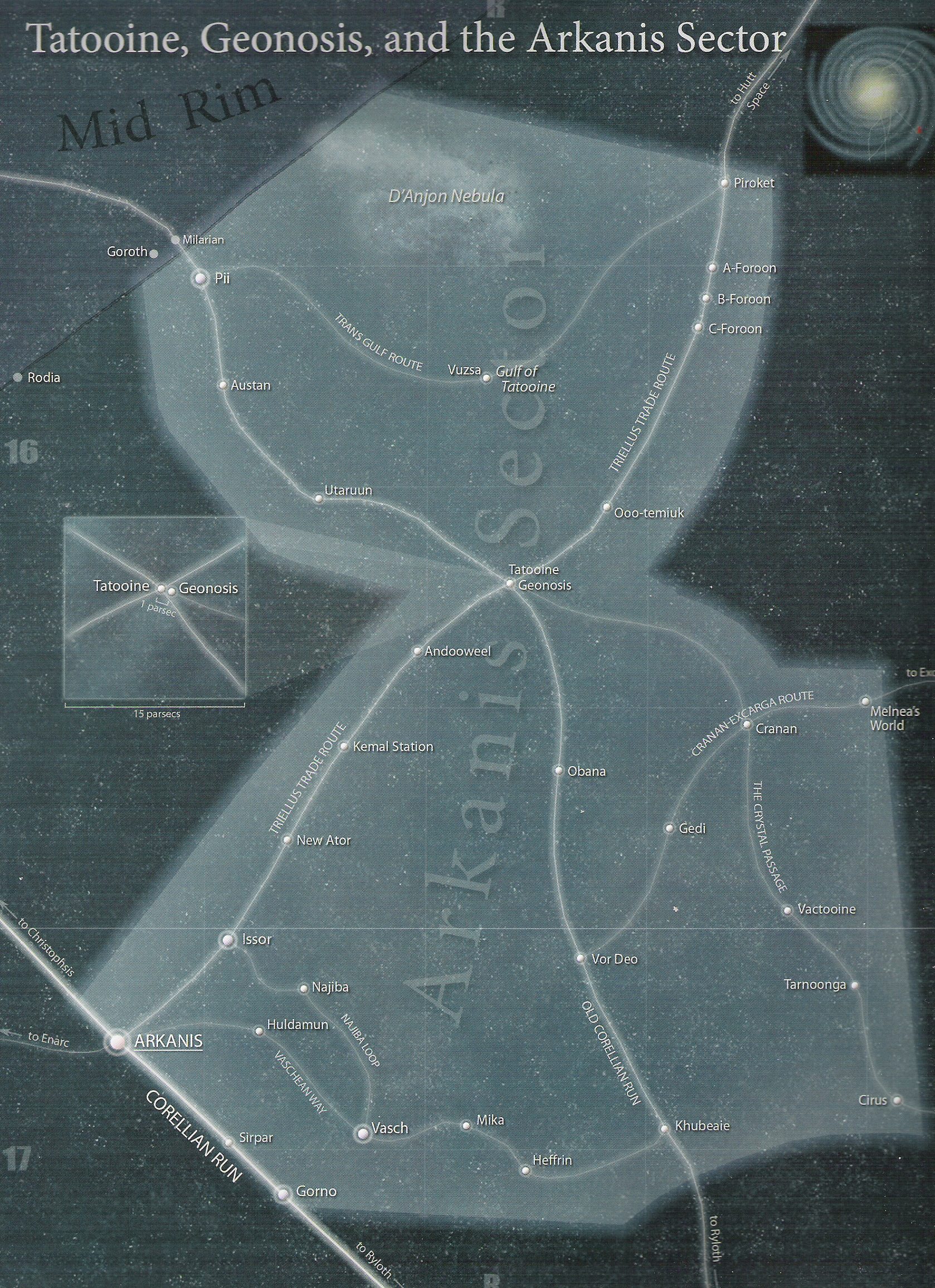
The Arkanis sector, a post-Ruusan Reformations sector of the Outer Rim Territories.
The basic political unit for much of galactic history was the sector, largely artificial divisions of space organized for political, military and economic reasons. After the first years of the Galactic Republic, the star systems of the Republic were organized into sectors limited to fifty systems with substantial populations. As the Republic expanded, the huge number of sectors led to gridlock within the Galactic Senate, and some sectors swelled to include thousands of inhabited worlds, even as galactic civilization continued to expand wildly, until there were millions of sectors.
This was not resolved until the Ruusan Reformations of 1000 BBY, which reorganized the galaxy into 1,024 regional sectors divided into constituent subsectors. The Chommell sector of the Mid Rim, for example, though fairly sparsely settled, contained some forty thousand inhabited worlds. Sectors by 0 BBY included cultural groupings like the Tapani sector and the Senex-Juvex, and business-controlled economic areas like the Corporate Sector, but generally they were fairly arbitrary groupings of planets and colonies of very differing fates and cultures, such as the Gordian Reach, the Arkanis sector, and the Anoat sector.
The Ruusan Reformations created a number of problems with sectorial representation that would not be resolved until the Republic's end. A moratorium was included on the creation of new sectors, but settlers kept pushing beyond the Republic's frontier, reclaiming systems lost during the New Sith Wars and settling new worlds. Some of these systems were annexed by existing sectors, which caused some outlying sectors to swell to gargantuan proportions. Others became de facto corporate possessions, or were directly administered by the Republic bureaucracy and denied Senate representation, though it was claimed that they were "virtually represented" by other senators. The old Core sectors saw the rimward megasectors as a threat to their ancient power and prestige, while the directly-administered systems complained that their "virtual representation" was a farce. The reforms of 124 BBY sought to address these issues, with many settled areas outside the Republic's borders becoming incorporated as freestanding subsectors, with their representatives reporting to the senator of an associated sector.
Until the final years of the Galactic Republic, sectors were governed by their senators, while the Supreme Chancellor had the right to appoint a Governor-General to coordinate military action within the sector during a state of emergency. Palpatine exploited this law frequently during the Clone Wars, culminating in the Sector Governance Decree, that appointed a permanent new class of military governors to the regional sectors - the Galactic Empire's Moffs. The Galactic Empire also created or carved out a number of new sectors, overturning the Ruusan Reformations' moratorium, including the Indrexu sector in the Greater Tion, and combined several freestanding subsectors to create the Baxel and Zuma sectors.
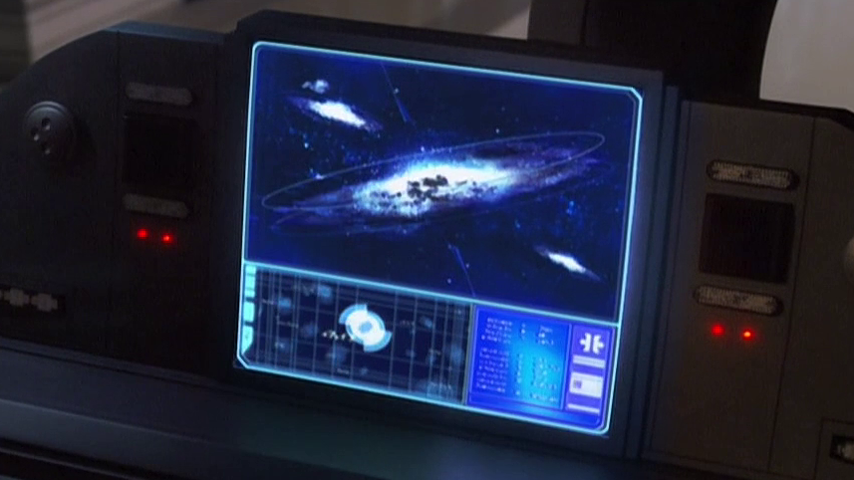
A map of the galaxy as seen in the Jedi Archives.
In the first years of the Galactic Republic, any planet with a large enough population was granted a seat in the Galactic Senate. However, even before the Galactic Republic had expanded beyond the Core Worlds, this system of government was unworkable: the Senate's sheer size made debate interminable and consensus almost impossible to arrive to. The Planetary Senate was thus reorganized, with sectors being formed of groups of up to fifty star systems to act as the new constituencies, while recognized representatives of a single planet or species still had the right to petition the full Senate. A prominent example of this towards the end of the Republic was Jar Jar Binks, representing the Gungan people of Naboo.
Planetary Governors represented the central government on a single planet. Their writ typically included the entire star system, though there were exceptions for systems that included multiple planets with huge populations or very different cultures, such as the Corellian system. In the eldest parts of the Core Worlds, systems and even individual planets were centers of political power, a relic of the Galactic Republic's origins. Elsewhere, systems were subservient in representation to subsectors, sectors and regions.
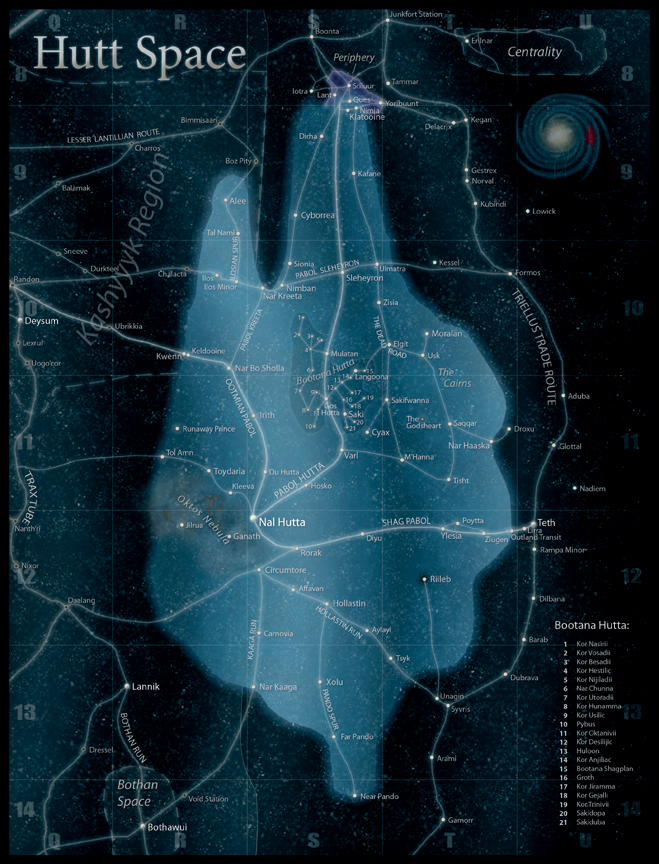
Hutt Space was a large stretch of the Outer and Mid Rims, dominated by the Hutts, that eluded central control for millennia.
The Allied Regions were independent states that freely joined the Galactic Republic as it expanded early in its history, with their rulers receiving the honorary title of Moff. By the time of the Clone Wars, most Allied Regions had been divided into sectors, but a handful endured as regions with a discreet cultural identity, such as the Trailing Sectors or the New Territories; or a sector dominated by a single species, such as Trianii Space. Several of these governments survived as client states under the Galactic Empire and maintained a degree of independence, and were recognized by the New Republic afterwards.
Hutt Space referred to the large stretch of the Rimward Slice controlled by the Hutt Ruling Council, the governing body of the Hutt species. Originally powerful warriors, the Hutt Empire overthrew the empire of Xim the Despot, but a disastrous civil war around 15,000 BBY known as the Hutt Cataclysms forced a cultural reformation, beginning a new philosophy known as kajidic, which stressed economic dominance over outright conquest. Hutt Space's borders ebbed and flowed over the millennia but the Hutts' power in both the economic and the criminal spheres endured, extending as far Coreward as Gyndine as the Galactic Republic decayed during the Separatist Crisis. Hutt Space was nominally part of the Galactic Empire, but the New Order largely tolerated the Hutts' criminal dealings, as the Hutt Ruling Council was a known quantity as opposed to the possibility of hundreds of feuding Hutt crime lords. Hutt Space was devastated during the Yuuzhan Vong War, but recovered surprisingly quickly, bringing with it a renewed Hutt militarism that was expressed when the region declared for the Confederation during the Second Galactic Civil War.
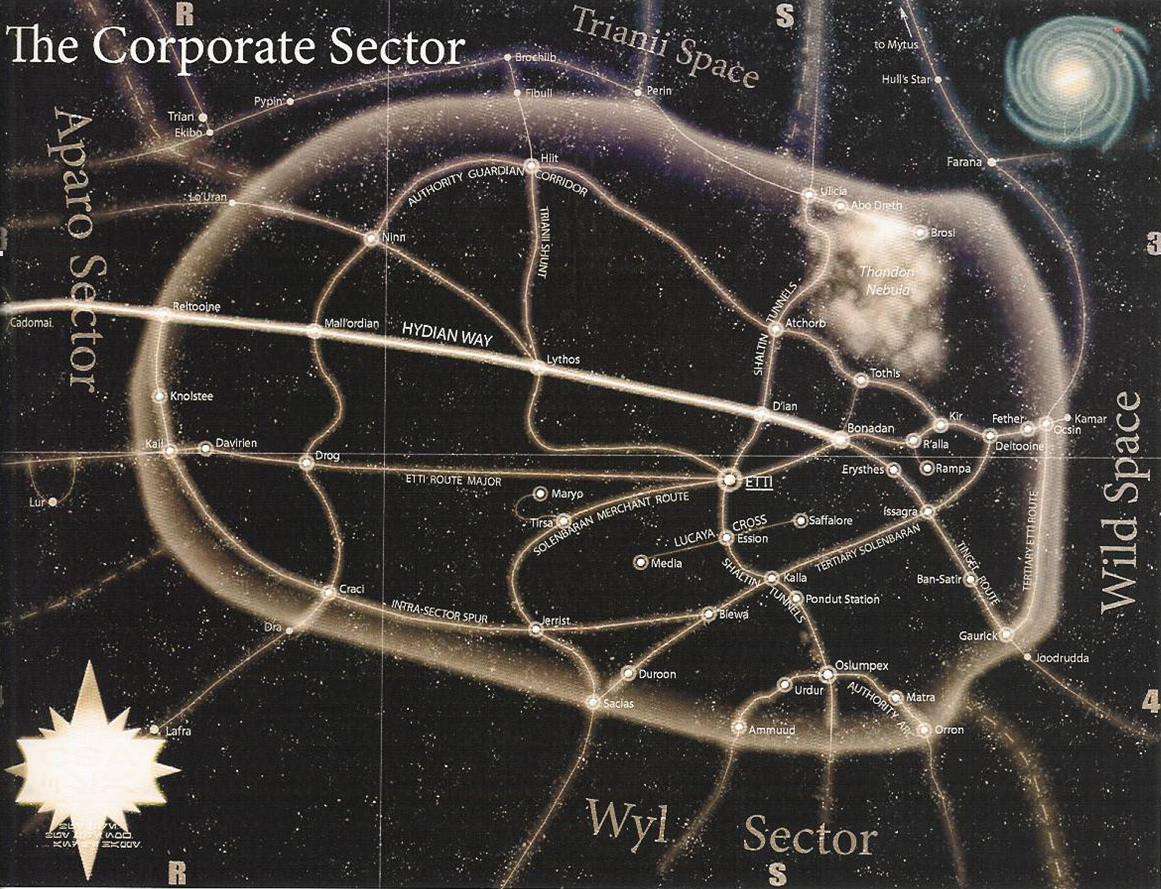
The Corporate Sector, on the edge of the Tingel Arm, was a business-dominated Imperial exclave.
The Corporate Sector Authority (CSA) referred to the government of the Corporate Sector, a region of close to thirty thousand star systems on the edge of the Tingel Arm ruled from Etti IV, and was a collective of businesses and corporations granted exclusive rights to all resources in the territory. The experiment in corporate governance, while protecting the rights of workers, began after lessons were learned from the Outer Expansion Zone scandal. At the suggestion of Baron Orman Tagge, the Corporate Sector was vastly expanded under the Galactic Empire and it became an officially-sanctioned refuge for Loyalist corporations seeking to avoid nationalization. The CSA became the region's sole owner, employer, government, and military, while corporations that invested in the Authority would receive proportional shares of the profits.
The Centrality was a long strip of territory to the north of Hutt Space, founded as a libertarian independent state in 3350 BBY. Human-dominated, the capital of Erilnar often fell under the influence of the Hutt kajidics, which were often the beneficiaries of the profits of the Centrality's main export, the life-crystals of Rafa V. The Centrality was formally an Imperial territory, but was generally left alone by Imperial Center. Emperor Palpatine's sole act concerning the region occurred several years prior to the Battle of Yavin, when he gave de facto control of the Centrality to Rokur Gepta, Sorcerer of Tund, who was later killed by Lando Calrissian in defense of the region's native Oswaft at the Battle of ThonBoka.
The Hapes Consortium was the monarchical government of the Hapes Cluster, located in the Inner Rim. Isolationist and matriarchal, the secretive Hapans became legendary for their reputed wealth, beauty, pride, and aristocratic feuds. Emperor Palpatine's tolerance of the region's independence surprised many, and it was suggested that the Emperor maintained Hapes as a lesson to the galaxy in the dangers of insularity and decadence. The Hapes Consortium opened its borders after the Declaration of a New Republic.
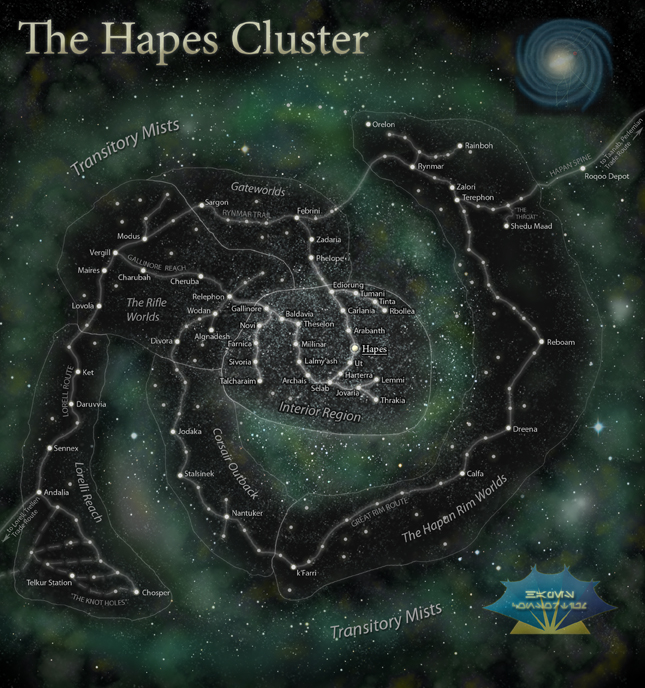
The Hapes Cluster was an isolationist grouping of 63 inhabited worlds ruled by the matriarchal Queen Mothers.
The Atrisian Commonwealth was a region of two hundred planets in the Core Worlds near the Unknown Regions. The political, diplomatic and military writings of Atrisia, in particular the Sayings of Uueg Tching, had been studied for millennia. The insular territory declared independence after Emperor Palpatine's death at Endor but later accepted Allied Region status in the New Republic. Similarly, Nouane began as a thriving Inner Rim empire beyond the Slice, and was renowned for its philosophers and thinkers, in particular the controversial Four Sages of Dwartii. Nouanese ministers were common in the young Republic, and the territory sought Allied Region status after being ravaged by the Mandalorian Crusaders in 3963 BBY. The region of 212 planets was a loyal supporter of the Empire and declared independence under the New Republic.
Bothan Space included some 150 settled systems in the Mid Rim, dominated by Bothan colonists and ruled by the Bothan Council. One of the few species close to Hutt Space to preserve their independence, the Bothans were credited with the diplomacy and espionage that preserved the stability of much of the Mid Rim. Bothan Space was one of the first regions to declare its support for the New Republic in 4 ABY.
The Botor Enclave and the Daupherm Planet States were two adjoining territories on the edge of the Core. The ursine Botori controlled two dozen star systems within a nebula while the Human Dawferim controlled just over thirty systems. The two states had fought no less than forty wars even after they accepted Allied Region status under the Galactic Republic, and both declared independence after the Declaration of a New Republic.
Herglic Space referred to the shrunken remnant of the Herglic Trade Empire. It consisted of some forty star systems around the Rimma Trade Route, but hundreds of worlds along the Rimma outside Herglic Space had substantial Herglic populations. Herglic Space was brutally suppressed under the Empire but regained Allied Region status under the New Republic and the Galactic Federation of Free Alliances.
The Ktilac Regions were a confederacy off the Perlemian Trade Route in the Inner Rim ruled by three species - the Ktilacs, the Murachaun, and the Tocoyans. Religiously fundamentalist, the region had evolved a common culture where each species was seen as complementary to the other two and the rest of the galaxy was seen as unholy. Each species ruled sixty-three star systems while another three were open to outlanders under strict conditions. The Regions maintained Allied Region status under the Galactic Alliance.
Paqwepori was a small cluster of ninety rich star systems just off the Corellian Run in the Mid Rim. Paqwepor Major's bazaars were popular destinations for Republic traders expanding the Corellian Run for eons. The Paqwepori were known for their love of business and ambition while despising any law that could limit individual expression or initiative.
The spread of technology and civilization throughout the galaxy led to the development of the galactic economy, the system of production, distribution, trade, and consumption of goods. Few planets were entirely self-sufficient, with some, such as the factory worlds of Telti and Mechis III, devoting their economies solely to the production of high-tech goods but relying on agriworlds for food. In turn, these agriworlds relied on on manufacturing worlds to supply heavy equipment to harvest and process foodstuffs, and chemical industries to produce fertilizers and pesticides.
The importance of the galactic economy meant that a number of megacorporations were able to acquire immense economic and political power. In the years prior to the Clone Wars, the Trade Federation, a conglomerate of shipping and merchant cartels, controlled the votes of hundreds of star systems in the Galactic Senate by making their commerce dependent on its Merchant Fleet and enforcing deals with the Trade Defense Force. Companies such as the SoroSuub Corporation, which under the Empire outright controlled the government of the planet Sullust, produced goods for hundreds of fields. TaggeCo controlled hundreds of star systems and dozens of subsidiaries, making it one of the galaxy's most influential organizations. Even relatively small businesses, such as the Figg conglomerate in the Greater Javin, commanded substantial influence on their homeworlds and sectors.
The main currency of the Galactic Republic was the Galactic Credit Standard, divided into ten decicreds.
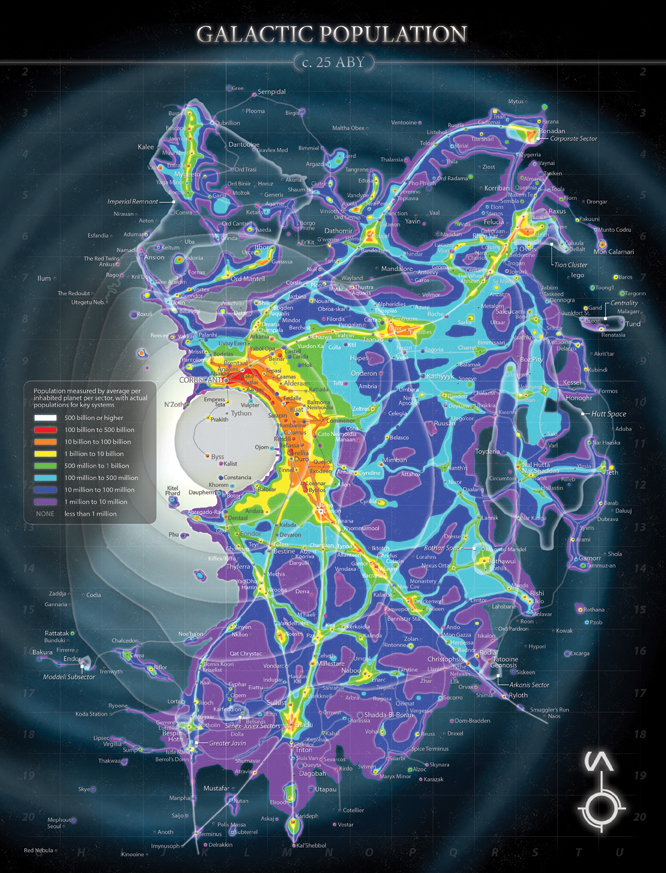
Galactic Population map
Of the galaxy's one billion settled systems, the majority of these were lightly-settled colonies of little note that were often not even marked on sector maps. The Chommell sector, for instance, contained thirty-six worlds that were sufficiently populated to merit representation in the Galactic Republic, but also contained 40,000 settled dependencies, in addition to 300,000,000 barren, unsettled stars.
During the days of the Galactic Empire more than 69 million systems met the requirements for Imperial representation, and 1.75 million planets were considered full member worlds. The population of the nearly 70 million systems that the Empire was responsible for amounted to more than 100 quadrillion beings.
Because only around a quarter of the galaxy's four hundred billion stars had been thoroughly surveyed, scientists were uncertain as to the true number of intelligent species. The Galactic Empire recognized five million intelligent species, though it was mathematically accepted that galactic civilization had yet to discover a large number of species and the total could be as high as twenty million.
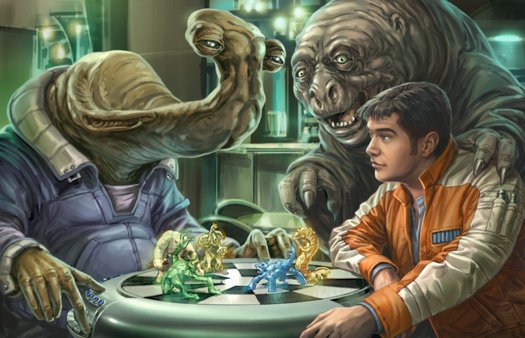
An Ithorian playing holochess against a Human opponent, as a Baragwin observes.
In classical history, the dominant species were Humans. Originating from the Core Worlds, Humans were the most populous species in the galaxy and so tended to form the basis of the major governments. Sentients other than Humans were sometimes known as "aliens," though the term "non-Human" was considered less offensive. Nevertheless, the Humanocentric definition of races was considered unacceptable by some, and simply another expression of unwarranted Human dominance. Other notable spacefaring species included the Baragwin, who had long since forgotten their homeworld and roamed the galaxy as merchants; the Duros, a founding species of the Republic and creators of the modern hyperdrive; the Herglics of Giju, the founders of the Rimma Trade Route; the Gran of Kinyen, who had settled countless colonies, including Malastare; and the Ithorians, who had long maintained great networks of Herdships for galactic trade, and transferred their civilization there after Ithor was devastated during the Yuuzhan Vong War.
Although not considered a race for obvious reasons, droids formed a significant part of society, helping and coexisting with the population. On Naboo, higher level droids were considered equal as fellow sentients.

Whether the Asogian expedition to another galaxy succeeded or not is unknown.
Extra-galactic travel was difficult due to a circumferential hyperspace barrier that prevented hyperspace routes very far outside the disk, and beyond this, the barren vastness of the Intergalactic Void. However, by the time of the Clone Wars, contact had been established with the two small galaxies orbiting the galaxy: the Rishi Maze, also known as Companion Aurek, and Firefist, also known as Companion Besh. The InterGalactic Banking Clan had influence as far as these locations.
The Extragalactic Society was an organization devoted to the search for life outside the galaxy. Two major expeditions were launched around the period of the Clone Wars in an effort to explore beyond the galaxy: the Outbound Flight Project was intended to settle another galaxy but was destroyed by the Chiss after it accidentally entered their territory in the Unknown Regions. In 19 BBY, during the last days of the Republic, the Brodo Asogi leader Senator Grebleips sent an expedition to another galaxy, but all information about the outcome of this endeavor remained unknown.
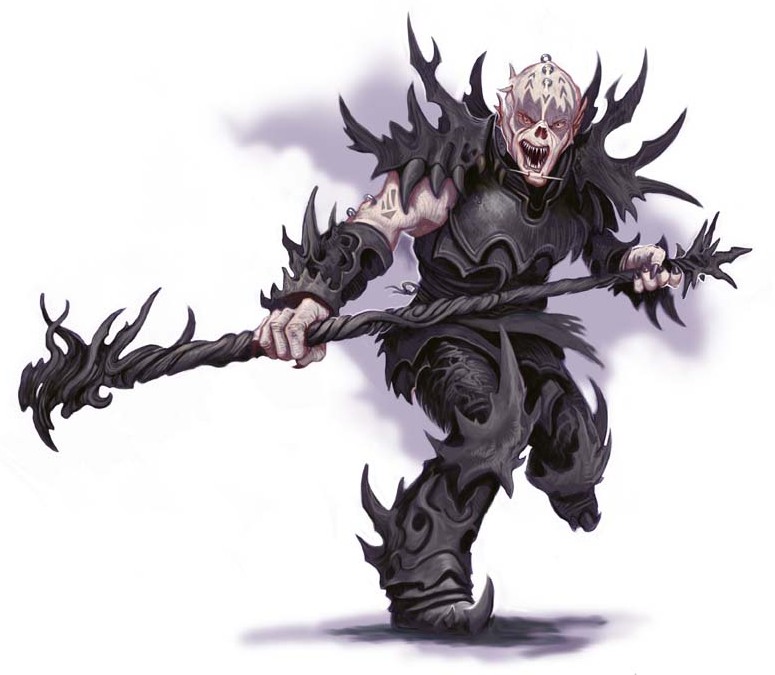
The Yuuzhan Vong were the most infamous extra-galactic species.
Just after the Battle of Endor, the Nagai and the Tofs, races native to the companion galaxy of Firefist, invaded the galaxy, the Nagai hoping to escape the Tofs, who had oppressed them for centuries. Assisted by the Alliance of Free Planets and the Mandalorians, the Nagai defeated the Tofs and returned to liberate their home galaxy, bringing the Nagai–Tof War to a close.
Among the best known extra-galactic aliens were those that had fled from the Yuuzhan Vong galaxy: the droid races of the Abominor and the Silentium, and the Yuuzhan Vong themselves and their slave soldiers, the Chazrach. The Abominor and the Silentium fought a devastating war before the Yuuzhan Vong rose up against both and drive them from their galaxy. Of those Silentium and Abominor that survived, two, the Great Heep and Vuffi Raa, established themselves in the galaxy proper around the time of the Galactic Civil War. The former was destroyed on Biitu and the latter was recovered by the Silentium after the Battle of ThonBoka.
After driving the Silentium and the Abominor from their galaxy, the Yuuzhan Vong turned inward and fought their own civil war, the Cremlevian War, which stripped much of their galaxy of life. Seeking a new home, the Yuuzhan Vong and the Chazrach crossed the Intergalactic Void for millennia until they arrived in the galaxy, beginning a religious war which almost destroyed galactic civilization while it was just recovering from the Galactic Civil War.
The lingua franca of the galaxy was Galactic Basic Standard, which had its origins as a Human language of Coruscant known as Old Galactic Standard. As the Galactic Republic expanded, Old Galactic Standard took influences from Durese, Bothese, and Olys Corellisi, becoming Mid-Galactic Standard by 15,000 BBY. Influence from the Dromnyr language after the Vultans joined the Galactic Republic around 14,000 BBY saw the evolution of Mid-Galactic Standard into the modern Basic. Humans being the dominant species of the galaxy, Basic was adopted by many non-Human species as well.
The second most common language was Huttese, expanded through the criminal and financial activity of the Hutts, and so it was adopted throughout the Outer Rim Territories by other species that were in close cooperation with them throughout the ages, such as the Rodians and the Toydarians.
The dominant writing system in the galaxy was Aurebesh, derived from the script of the Rakatan Infinite Empire by its former subject species after the Empire collapsed, though the symbols themselves were possibly much older. Aurebesh spread throughout the galaxy during the Tionese War between the young Galactic Republic and the Honorable Union of Desevro & Tion, when the new Republic Military found it needed to standardize its communications, and so adopted the writing system of Coruscant. The second most-common writing system was the High Galactic alphabet, promoted by Alsakan after 17,000 BBY during the Alsakan Conflicts as part of its efforts to be recognized as the galactic capital. Derived from Tionese characters, the High Galactic alphabet was popular among the upper class, and as late as 22 BBY, one-third of Republic citizens who spoke Basic used the High Galactic alphabet. Consequently, notices were often written in both Aurebesh and High Galactic.
No serious attempt has been made to give the galaxy an official astronomical name. It is generally referred to by the out-of-universe descriptive phrase "the Star Wars galaxy". According to The Essential Atlas, the Nagai of Firefist refer to the main galaxy as Skyriver, which it is the closest any official material has come to giving the galaxy an in-universe name. We don't know, however, whether or how members of the galactic community refer to their own home galaxy (the way we call ours the "Milky Way").
"The Galaxy Far, Far Away", often abbreviated GFFA is the unofficial name given by many fans to the that is the setting for the Star Wars films and their spin-offs. This galaxy in the films is referred to simply as "the galaxy." It springs from the introduction present at the beginning of each of the films, many of the video games, and even some fan films and novels:
Eventually the use of the acronym GFFA became so prevalent that Del Rey named the post-New Jedi Order government, the Galactic Federation of Free Alliances, in honor of the term.
The opening words of each Star Wars film place that galaxy in the same plane of existence as ours, as they declare it to be a finite distance—"far, far away"—from us, but nothing more of its location has been revealed. Humans exist in both galaxies, and Galactic Basic is essentially the same as modern-day English, including (but not limited to) its British, American, New Zealander, Caribbean, and Indian variants. Additionally, many cultural traditions (from the handshake to marriage) are similar or identical in both galaxies, but these similarities remain unexplained.
Similarly, the time frame the galaxy and the events occurring in it occurred in compared to that of Earth is not made clear other than the opening words declaring that they took place "A long time ago." The teaser trailer for A New Hope opened with the line "Somewhere in space, this may all be happening right now..." It should be noted that, originally, when George Lucas was writing the first film in its initial treatment, he had intended for the galaxy to not only occur within the same galaxy as our own, but the time frame would have been specifically cited as occurring within the thirty-third century. Walter Murch, an associate of Lucas' since his days working at American Zoetrope, implied that part of the reason for the decision to change the setting to occurring in a galaxy "far, far away" from our own was so Lucas could both make the movie and at the same time get away with pushing anti-Vietnam War messaging in the film as a transubstantiated remake of Apocalypse Now, as he could not get the message out directly due to the events of Vietnam still occurring at the time Lucas started making Star Wars. George Lucas in The Making of Star Wars gave a similar reason for the change.
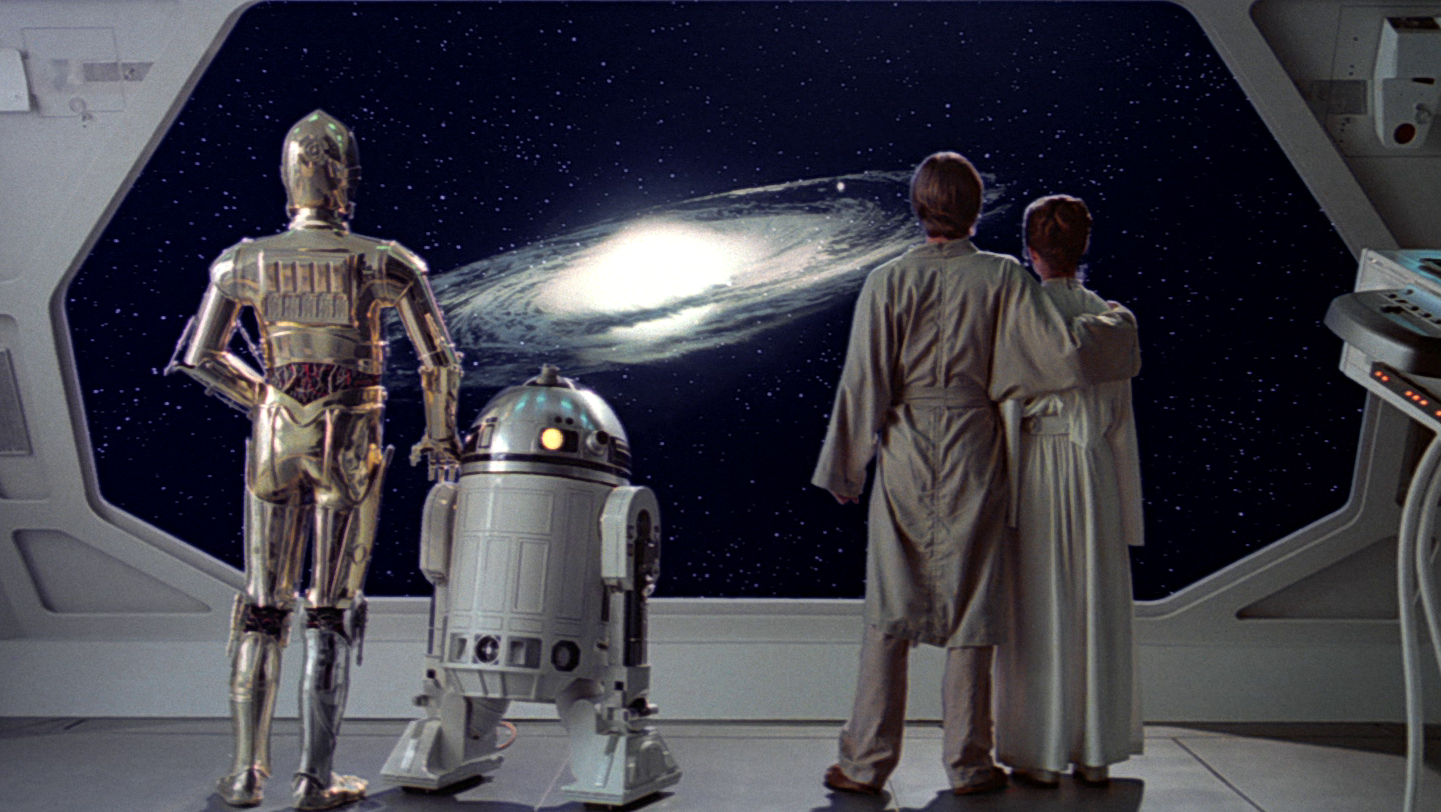
The controversial scene from The Empire Strikes Back
At the end of The Empire Strikes Back, characters aboard the Rebel fleet see a celestial object from some distance away. Some fans have said that it rotates too fast to be a galaxy and at that distance a galaxy would not emit as much light as is portrayed in the film.
Some sources have said that the fleet spent some time hiding outside the galactic disk, probably intending to refer to this scene. According to the 1996 Tales of the Bounty Hunters story Of Possible Futures: The Tale of Zuckuss and 4-LOM, the object in the film is the galaxy, and the Rebel fleet had journeyed to a point in space far removed from the galactic plane. This point was not outside of the galactic plane, per se, but rather above the galactic plane.
Since the release of Tales of the Bounty Hunters, the object has been inconsistently identified. The Complete Star Wars Trilogy Scrapbook, first released in 1997, identifies the object as a spinning star formation. In 2002, the Episode II DVD-ROM Exclusive Content stated that the bright object may be the cluster known as the Rishi Maze. In 2003, Leland Chee confirmed on the StarWars.com that the object was indeed the Star Wars galaxy, which was reinforced by the release of The Essential Atlas in 2009, which established that the Rebel fleet regrouped at a point above the galactic plane.
Several publications have contained "maps" of the galaxy, although they are at best two-dimensional projections of a three-dimensional galaxy. The first maps of the Star Wars galaxy were published in roleplaying game sourcebooks by West End Games, and contained detail maps of regions and sectors. The Elrood sector was mapped in Planets of the Galaxy, Volume Three, the Brak sector in Flashpoint! Brak Sector, the Kathol sector in The DarkStryder Campaign, and the Tapani sector and the Rimma Trade Route in Lords of the Expanse.
Despite these partial maps, it would not be until 1998, with the release of the CD-ROM digital encyclopedia Star Wars: Behind the Magic that the first full, official galactic map was released. This map placed the most important planets from the films and the Expanded Universe. The map provided a top-down view of the Star Wars galaxy, with concentric rings indicating the various regions from the Deep Core to the Outer Rim Territories, as well as placing Naboo, which would feature in the upcoming The Phantom Menace.
1999 saw the release of The New Jedi Order series, which included a detailed galactic map in each novel that tracked the course of the Yuuzhan Vong invasion. The maps in these books showed an isometric projection of the galaxy, and included the spiral arms and empty galactic west known as the Unknown Regions. Each novel included the same basic map, which mapped planets from the existing lore as well as newly visited worlds of the New Jedi Order stories. 2000's The Essential Chronology used the same map in its endpapers.
Inside the Worlds of Star Wars: Episode I, also released in 2000, returned to a map using concentric circles, similar to the Behind the Magic map, but with broadly similar planet placements to The New Jedi Order map. Other maps, however, beginning with Star Wars Gamer 5, elaborated on the concept of The New Jedi Order map, and increasingly-detailed color maps were published in some issues of The Official Star Wars Fact File (1, 56, 139). A large poster map was provided in 2003's Star Wars Insider 65, and The New Essential Chronology of 2005 also had a spread with an updated galaxy map and its most notable systems, and was the first to mark the locations of the planets of Revenge of the Sith.
2009 saw the release of The Essential Atlas, which did away with isometric projections in favor of a top-down chart, while keeping regional borders and planet placements largely the same. As well as a large galaxy map, The Essential Atlas also included numerous historical, regional, and sectoral maps and developed a coordinate system and galactic compass. In addition, The Essential Atlas included an index of 4,387 star systems, assigning each a coordinate, sector and region. The Essential Atlas has since been expanded with an Online Companion, which includes an updated index placing 5,085 star systems, believed to be every system mentioned in Star Wars Legends, as well as maps of the sectors of the Outer Rim, Mid Rim, and Expansion Region.
The chapter selection of Star Wars: TIE Fighter (1995) was the first appearance of what can be considered a galaxy map, consisting of a generic galactic shape on which the supposed location of the current mission is highlighted; the highlights, however, do not correspond to canonical coordinates of said locations (e.g. selecting the Greater Javin campaign wrongly highlights the Galactic Core). The 1998 video game Star Wars: Rebellion would provide an interface of a galaxy map divided up into 20 sectors and 200 systems; however, these positions are provided only as a game mechanic and have been contradicted by later official sources.
- LEGO Star Wars: The Phantom Menace
- LEGO Star Wars: The Dark Side